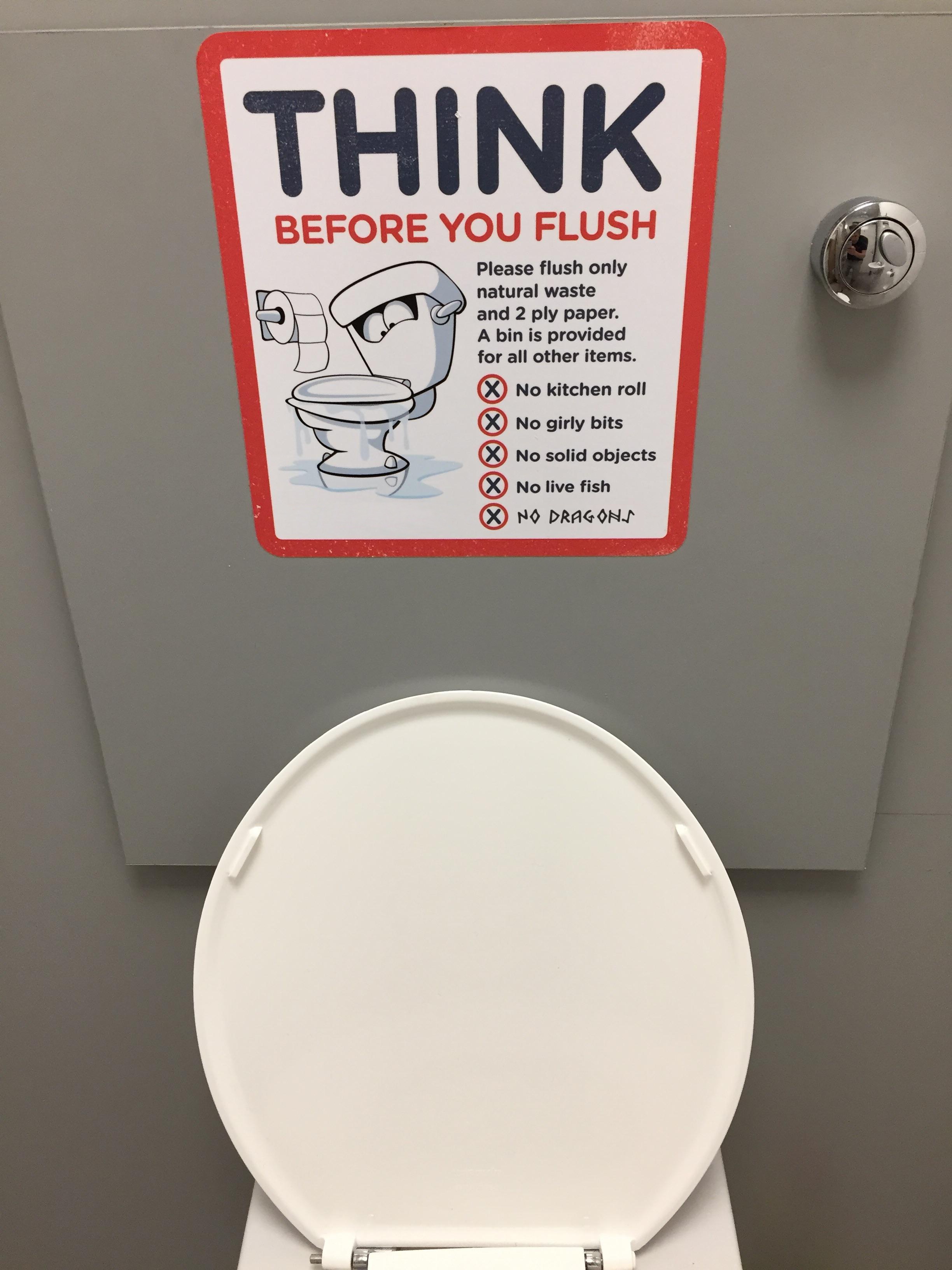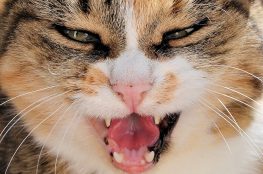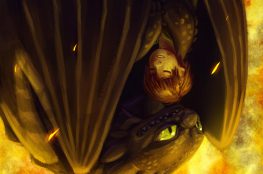The Hidden Shrek? Or: How to Flush Your Dragon?
Living in Australia, I managed to see the movie when it was first released to theaters here on January 3 2019. One of my first impressions was, that it was made so blatantly clear in the film trailers what the story was about, that there weren’t too many surprises left. This wasn’t necessarily a bad thing, as anything new that wasn’t revealed in the trailers did keep the story chugging along, and also helped prepare the devoted big and small fans for the so-called “bittersweet ending” that we were told would happen.
At the end of the movie, around a third of the children in the cinema on the day were crying and inconsolable.
Along with the predictably positive professional reviews for this movie, at the time of writing this review (January 5), there are already several glowing moviegoer reviews on the biggest movie reviews and information website.
The reviews were mostly from people with accounts that are apparently many years old, but they had never left a review for any other movie or made any other real contribution to the movie information website. I’m not entirely sure what to make of that, but let’s move on…
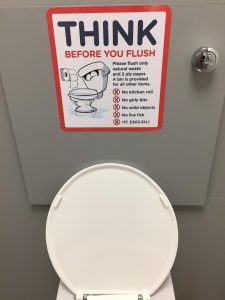
(Click on pictures to show them in a “lightbox”. Click outside the picture, on the X or browser/phone back button to close. Plot points not already shown in the film trailers won’t be revealed, possible spoilers marked.)
This final instalment in the “How to Train Your Dragon” story does have some interesting twists and turns, but perhaps not all of them are going to make sense – especially to viewers who’ve been following this story from the beginning, with the hit first movie from 2010.
Also, it does feel like several worn out clichéd tropes have been pulled out, to bring the story to its predestined ending with the minimum of effort and maximum of superficial neatness.
The previous two movies raise an expectation for the story to further explore the strengths and weaknesses of the characters to reach a more mature and thought-out path. This should happen even if it were to reach the same conclusion – that the dragons must leave, to live in the “Hidden World” (the ancestral home of all dragons).
Unfortunately, there’s mostly just quiet and uncharacteristic acceptance amongst the Dragon Riders – as seen in the film’s trailer with Hiccup saying “you’re right bud, it’s time (to go)”.
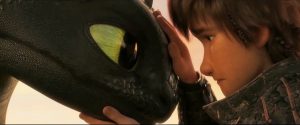

It seems the story was written with the end-goal in sight, and the quickest path to it was then plotted, ignoring the richness of the previous character and story developments… but what to make of the uncharacteristic changes to the Dragon Riders’ personalities? Even the dragons themselves were “different” in ways.
Before continuing with this review, here’s the official synopsis of “How to Train Your Dragon: The Hidden World”:
As Hiccup fulfills his dream of creating a peaceful dragon utopia, Toothless’ discovery of an untamed, elusive mate draws the Night Fury away. When danger mounts at home and Hiccup’s reign as village chief is tested, both dragon and rider must make impossible decisions to save their kind.
In case you’re new to the How to Train Your Dragon (movie franchise) story, here’s a description taken from the Wikipedia page (January 5):
The franchise follows the adventures of a young Viking named Hiccup Horrendous Haddock III, son of Stoick the Vast, leader of the Viking island of Berk. Although initially dismissed as a clumsy and underweight misfit, he soon becomes renowned as a courageous expert in dragons, beginning with Toothless, a member of the rare Night Fury breed as his flying mount and his closest companion. Together with his friends, he manages the village’s allied dragon population in defense of his home as leader of a flying corps of dragon riders. Dean DeBlois, the director of the trilogy, described its story as “Hiccup’s coming of age,” taking a span of five years between the first and second film, while explaining in the third and final film why dragons no longer exist.
(Start of possible spoilers)
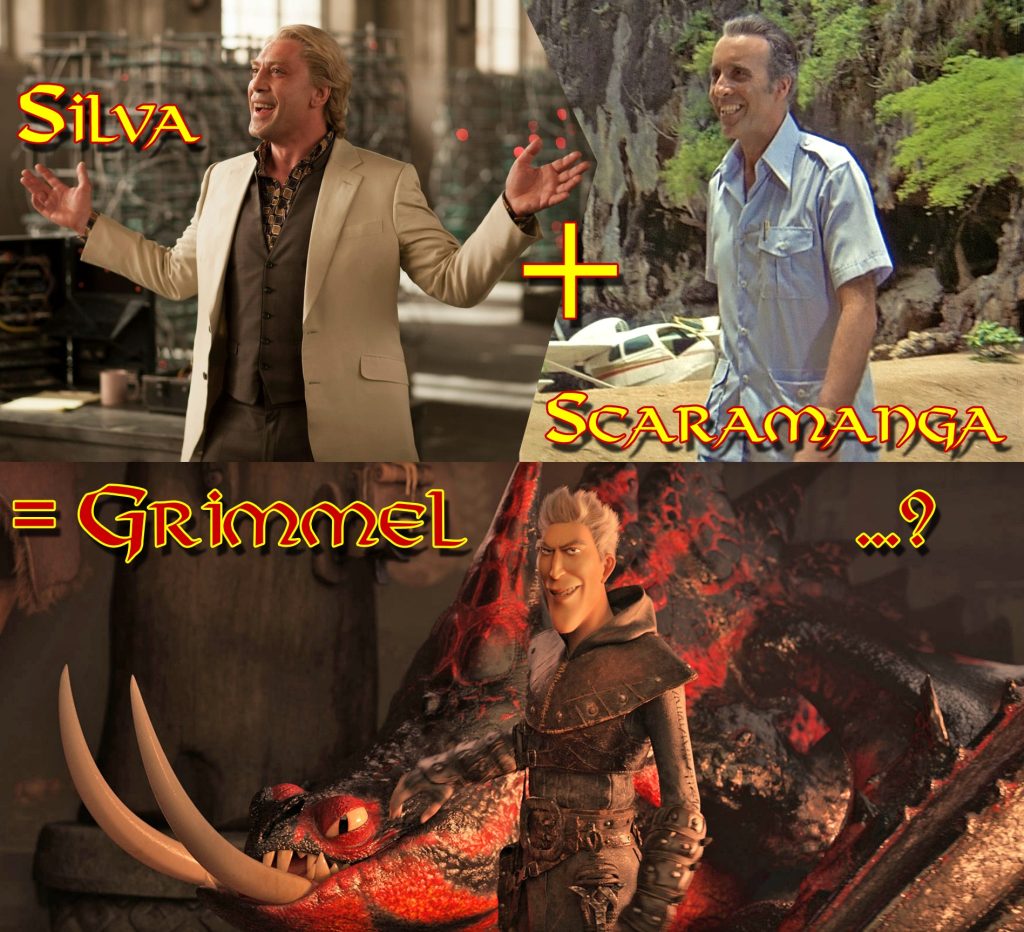

According to “Grimmel the Grisly”, the main antagonist of this movie: he had killed every “Night Fury” dragon, except for Toothless. This would have been extremely dangerous and difficult. Therefore, it came as a surprise that he didn’t actually have an especially compelling reason to kill every Night Fury.
Grimmel (the dragon-killer) appears to be a mix of two James Bond film villains: Francisco Scaramanga (sociopath, sharpshooter, hunter) from the 1974 film “The Man with the Golden Gun”, minus any usable character development and depth that may have been sparsely present in that movie, and Raoul Silva (highly intelligent, cunning/tenacious, nutjob) from “Skyfall” (2012).
Grimmel was reduced to the scary, dangerous plot device whose fanaticism would cause the realisation that the story must end. A few near-anonymous somewhat-international-looking warlords (apparently to make the scale of the dragons’ enemies look bigger) with constant frowns on their faces and a hundreds-strong armada of nondescript battleships hidden amongst the mist, are hastily ushered in to seal the story’s fate.
As shallow and reduced a character that Grimmel was in this story, or because of it, the final battle with Hiccup was truly vicious, with Grimmel tearing at Hiccup like a rabid wild animal. It was indeed a violent battle, that exceeded the sheer baseness and brutality of a number of battles in the James Bond movies. The simple plot device, who went out with a sadistic, debased bang. (Not exactly suitable for kids, really – very graphic and ugly.)
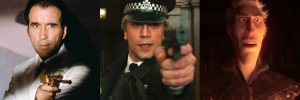

It’s almost like Scaramanga and Silva had a psychotic kid… somehow.
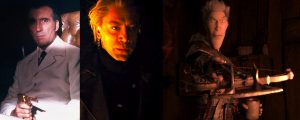

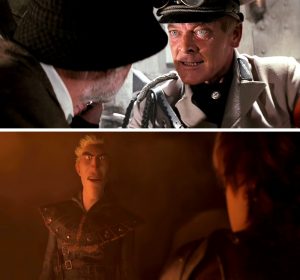

Just for good measure, it seems Grimmel also had a healthy dose of Colonel Ernst Vogel from “Indiana Jones and the Last Crusade” blended in (outgroup prejudiced, sadistic, ruthless), helping morph Grimmel into the antithetical character of who Hiccup is.
As suggested here and there and in the movie: Grimmel is the evil character that Hiccup would have become, if Hiccup had killed Toothless instead of freeing him. Even the name “Grimmel”, Luxembourgish term derived from Middle High German, translates to “crumb”.
The word “Grimm” also happens to be a German word, which can describe someone as being “fierce, full of rage, wrath and vengeance”.
The terms “Hiccup” and “Crumb” could both have been used to describe a runt of a child. Perhaps Grimmel himself, was a runt boy who decided to prove himself to his tribe by killing, rather than befriending the first Night Fury that he came across.
With so much meaning crammed into a name, had this guy been called Jeeves or Clive, he would have served everyone breakfast and then told entertaining inoffensive lighthearted jokes and stories.
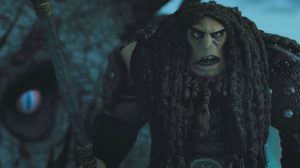

One can’t help but get a sense that Grimmel (The Wrathful Crumb), as well as this final movie overall, very much is a copy/reboot of the second movie. Learning from the experience and driving home the desired message of the movie’s story with extra (perhaps too much) enthusiasm the third time around, and then tacking on the necessary ending where the Vikings and dragons part, to add something new. Was Drago Bludvist 2 Grimmel even necessary?
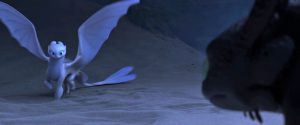

The “Light Fury” is a subspecies of the Night Fury dragon. Being the love-interest of Toothless and possibly his only chance of ever finding a mate, she remains wild and wary of humans, and as a result gets reduced to the binary function of driving Hiccup and Toothless apart, and becoming Toothless’s mate.
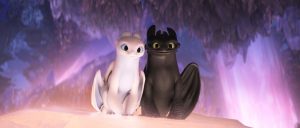

Becoming the alpha’s mate would make her the “Queen of Dragons”. She almost (and unfairly) gets brought to the point of directly taking the “blame” for the separation, as the “home wrecker” that helped ruin the great friendship and story, with her allure and fancy footwork when she’s alone with Toothless. He is so enamored by her, and her incarnation of “The Call of the Wild”, that he is the first to start taking on new and independent roles, as the Dragon Riders’ situation becomes increasingly desperate.
Toothless begins to separate himself from his home and best friend Hiccup, despite him being in the midst of a dangerous and deadly cat-and-mouse game with Grimmel, and Hiccup being the mouse.
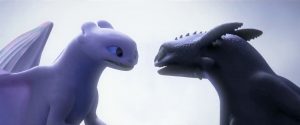

The scenes between Toothless and the Light Fury are cute, and they clearly end up caring for each other, which was nice to see.
Toothless practicing for his future meetings with the Light Fury was adorable and a rare and humorous highlight, but he was uncharacteristically mocked by some of the Dragon Riders for this.
There was selfish laughter and derision aimed at Toothless, uncharacteristic of actual team members and friends, but rather characteristic of one’s enemy. This behaviour doesn’t fit naturally into the overall HTTYD story – it would not have happened in the previous movies or TV series.
(Note: The Viking Age Norsemen considered any mockery towards another, a terrible crime punishable by death. Had the Berkians been “real”, then anything even hinting of mockery towards Toothless by a tribe member would never have been tolerated.) (Source.)
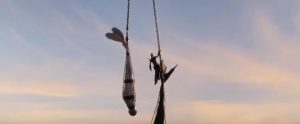

Possibly to lessen the negative view that the audience may develop of her, the Light Fury performs an act of selflessness one would have expected of a tame and friendly dragon, and showed small signs of becoming more trusting of Hiccup, although her predestined divisive function in this story quickly returned, due to a carefully-timed series of bad luck “coincidences”.
Being the last Night Fury, Toothless never had the chance to spend time with a possible mate. However after meeting the Light Fury, his almost negative, annoyed and dismissive behaviour towards his best friend Hiccup, was still unexpected and uncharacteristic of the dragons overall.
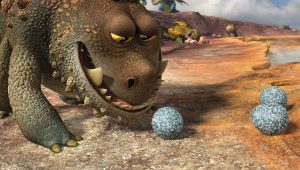

In the 2011 short film “Gift of the Night Fury”, we see all of the Dragon Rider’s dragons, in fact every single dragon, leaving unexpectedly for an unknown reason.
Later on, it turned out that the dragons had left to lay and hatch their eggs on another island.
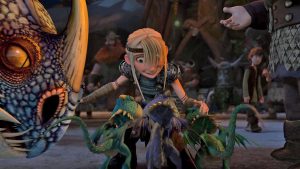

The dragons more than happily returned with their newly hatched young, back to (Berk) the Dragon Rider’s island, and celebrated the new additions to the family with all of the overjoyed Vikings there.
The dragons clearly weren’t letting the finding of a mate, get in the way of their friendship with humans – especially since nobody seemed to notice changes in their behaviour before temporarily leaving to hatch their eggs.
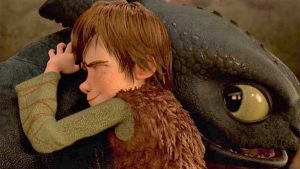

The friendship between Hiccup and Toothless was quite possibly the strongest of any – for it to be seemingly dismissed and undone, even for a moment, would seem uncharacteristic for a dragon and therefore also Toothless.
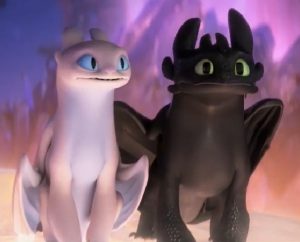

In the end, Toothless needed a drastic do-or-die reminder to grudgingly leave the Hidden World and return to the surface, and his friendship with Hiccup, after only a few short moments with the Light Fury. It’s like Hiccup got in the way of Toothless being king, with his new known-for-five-minutes queen by his side.
This is an unusual and stark contrast to anything we’ve seen before.
Toothless was dumbed-down from a best friend/family/tribe member with shared values and near or equal human intelligence, to a begging, tail wagging, fetch playing and unneutered pet. The other Dragon Riders’ dragons appeared to have no real personality or presence anymore – they were simply there, like cowboys’ horses.
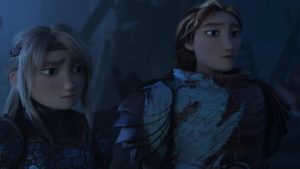

Also unusual, was the back-seat position that Hiccup’s mother Valka took on in this movie: mostly being just a prop and object of bizarre and disrespectful romantic affection with a young Dragon Rider, that was even partly reciprocated.
Hiccup’s long-time girlfriend and love, Astrid, also appeared to have a noticeably weakened role in this movie. It’s almost like they weren’t there anymore, breezing through the movie’s scenes and story, becoming nearly interchangeable with background characters.
Astrid and Valka are characters that previously played important roles whenever they were shown, and they, along with the other Dragon Riders, slipped into the shadows this time around.
Their behaviour and relationship with Hiccup seemed more like that of the distant and quiet team member, who occasionally walked in with a rare moment of advice or carefully-chosen words, rather than the relationship of future wife, and parent.


In fact with all of the Dragon Riders, there appeared to be virtually no chemistry, and instead mostly just the disconnected motions of everyday life with people important almost entirely in title only, rather than also heart and soul!


At least in the case of Valka however, this reduction in her significance is quite possibly an intentional tactic to deflect and move on from events from the previous movie: the revelation that Valka was kidnapped by a dragon while Hiccup was an infant, but never returned once she was able to – with everyone believing her to be killed.
As the only member of her tribe with compassion (and different viewpoint) towards the dragons, there would have undoubtedly been harsh and isolating realities and situations facing her, even though her husband Stoick clearly did love and protect her regardless.
In the first movie, Hiccup was very obviously treated quite badly for thinking and being different from the mainstream of the time.
Reasons aside, never returning was still abandoning her important role as mother, role-model, partner and tribe member.
Had her role been strengthened any more in this movie, the story would have had to further delve into the emotional area of explaining her shunning the duties and honour (and many disappointments and joys) of parenthood. The consequence of which, would have led to exploring those damaging effects this had on everyone else – especially on Hiccup.
Any further exploration of this might have caused more harm than good to the movie franchise overall, as family will still always come first in most peoples’ lives.
Having said all that however, in the original HTTYD book series, Hiccup’s mother “Valhallarama” wasn’t exactly “Mother of The Year” either (despite still loving Hiccup “long-distance”), and Vikings certainly weren’t known for their understanding and sensitive modern parenting style!
Some unusual elements of this third movie, seem to have had their beginnings in the previous (second) one, where already some viewers had started complaining about the story becoming overly crowded and difficult to connect with.
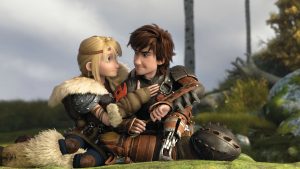

Had Astrid played a stronger role in this final movie like she had in the previous one – especially as a true partner and future wife of Hiccup – then perhaps Hiccup would have been expected by the audience to find even more courage, stability and strength than he actually had in the end.
Hiccup’s inventiveness and youthfully brash confidence that was always seen earlier, may have held up better after being tested by adult responsibilities. However, if that had happened, then the Hidden World’s ending would have looked more like something that made more sense to the followers of this story, and apparently that wasn’t this movie’s aim.
The Hiccup in this third and final movie, had at no point shown inventiveness, or actual confidence – but rather, hollowed motions that crumbled when tested.
A far cry from the Hiccup shown in the final scenes of the first and second movies.
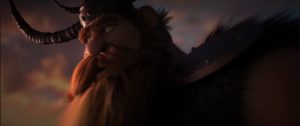

Stoick’s influence and death in the previous movie, was almost brought to the point of mockery in this one.
Mentions of Stoick and his role in the lives of his tribe’s people and family were generally unauthentic and distant.
Stoick appeared to have been replaced by nothing but an ignored anonymous face carved in Berk’s mountain, the telling of two memories and a means of further advancing unusual plot changes.
This integral character didn’t really return in any effective way: but rather appeared misused by the story, as a way to plant a thought into Hiccup’s mind that would apparently make the final movie easier for its creators to finish.
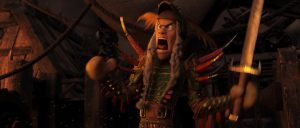

There was an inescapably unusual, overbearing and foreign element of forced slapstick comedy that never felt quite right, and never seemed to incite laughter with the audience in the cinema. Although the scene with an imprisoned Ruffnut (a female Dragon Rider) did come close – many people were grinning.
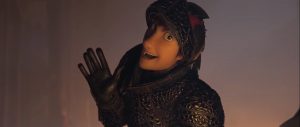

The slapstick comedy in the entire TV series was also quite ridiculous, but more natural in its execution, true to the characters, and seemed to add to the story rather than distract from it.


The comedy and story in this third movie simply doesn’t feel quite right.
(End of possible spoilers)
A true sequel… or an alternate reality?
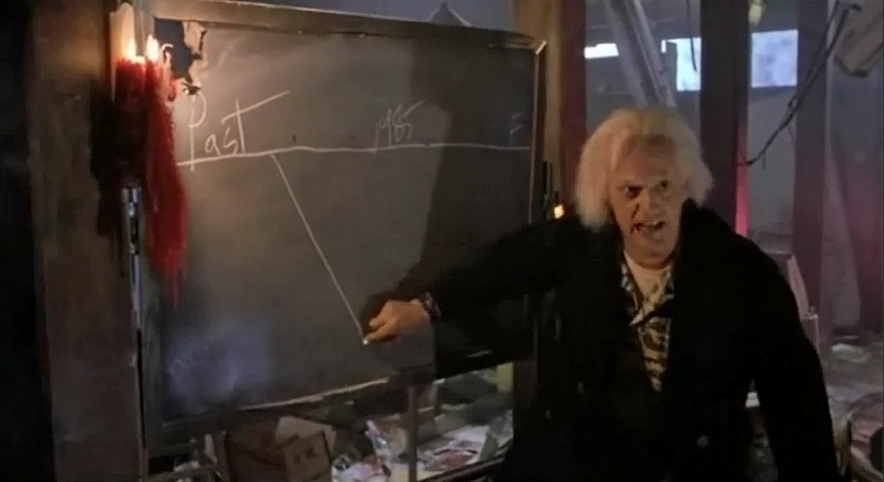

The third and final HTTYD movie could have easily gone in a completely different direction, with the same enemies and indeed the Light Fury:
Had this movie continued on the path set by the first and second movie, then Hiccup and Toothless would have decided on a more thought-out reason to separate after their latest battle.
The Dragon Riders and dragons likely would have regrouped and invited the Light Fury to their inner circle. Then together, they would have fully realised that their current problems and methods of handling them are unsustainable. Then, they would have begun working out some better ways of dealing with those problems, and finding a better-planned transition to a long-term solution.
Vikings and dragons parting was predestined, but could have happened with greater emotional intelligence and staying true to the groundwork laid by the previous movies (and TV series) – even within the time constraints of a single movie.
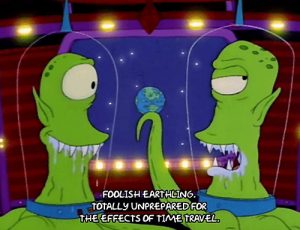

It’s not the fact they parted that doesn’t seem right with this story, as the reasons were indeed made quite compelling. It seems that changes were made to the characters’ personalities to apparently fit a certain kind of “alien subplot” which not only didn’t fit the overall reality within this long and detailed HTTYD story spanning the last nine years, but quickly overpowered it.
The characters no longer seem to act, in ways true to their previous behaviour.
How could a true sequel have ended?
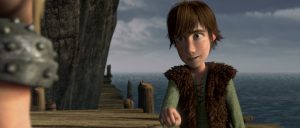

What could have easily become a trope twist in the last part of the Hidden World story, is that the ending and its reasoning process was a made-up illusion by Hiccup, the Dragon Riders and all of Berk’s inhabitants to trick the fast-approaching outside world into believing that all dragons were gone for good now.
The story could have ended, with the final scenes showing Hiccup’s tribe still in contact with their dragons, except now hidden to the outside world. To replace the dragons’ previous uses, common animals and new practices could be brought in to take over the tasks that the dragons once had. Occasional sightings could have been dismissed into tales of myth, and the world would have moved on to discover and create other machines of war instead of trying to enslave and use dragons.
The Loch Ness Monster is a myth… or not?
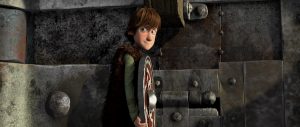

Once the movie’s viewers had witnessed the sad scene where the Vikings and the dragons parted, we could have heard Hiccup’s narration say something else than what was actually said in the movie; Hiccup could have said: “…at least this is what we want the world to believe, as they’re not ready for dragons yet”.
Hiccup could have gone on to explain that many of the dragons did enter the Hidden World, but were free to go out and visit islands uninhabited by humans. This could have happened, as long as they made sure not to draw attention to themselves anymore, and always used (bird-like in appearance) sentinel dragons to look out for humans. Toothless, being the alpha dragon, could have taught and enforced this. Taught that until the world is truly ready, they’ll remain hidden or get slaughtered again.
Hiccup would have then been in a more powerful position, one from leadership and wisdom, to make a clear moral message for this story not to exploit nature, our friends and the lives around us for selfish reasons. This ending would have been closer to the original book series’ ending as well. What a wasted opportunity.
Instead, an overpowering alien subplot was skewered into this story – it was skewered, as this story could have easily still worked and ended well without it.
(Can you come up with a better ending, or do you like the official one? Let us know below, but please mark spoilers.)
Could this skewered turn of events be explained by time travel gone wrong? Perhaps more likely:
When aliens or Brain Slugs take over a story…
(Start of possible spoilers)
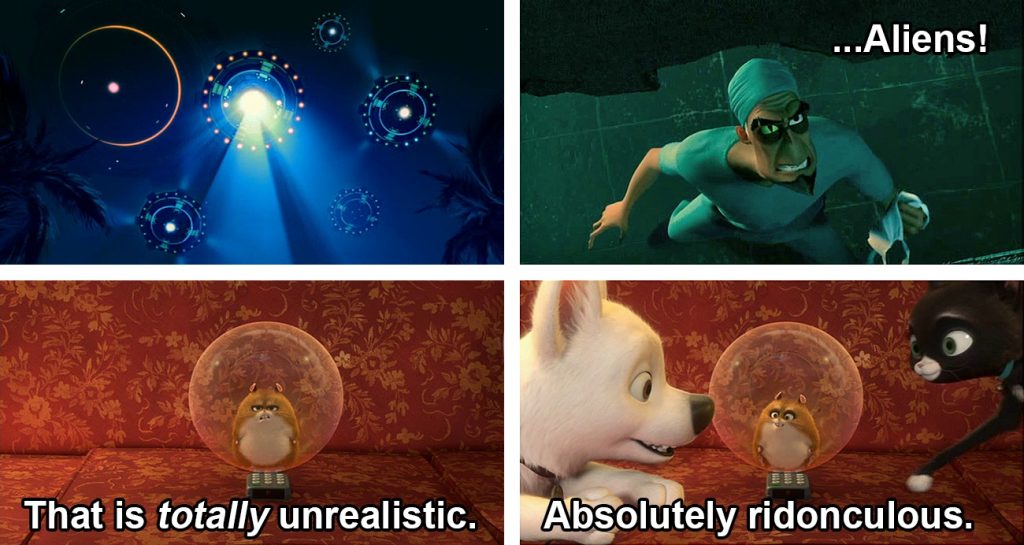

In fact, this alien subplot was skewered so brazenly, it left many weaknesses and plot holes as a result, which the viewers are supposed to simply accept.
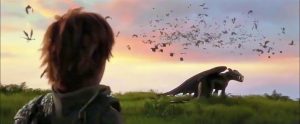

For example: Near the end of this movie, immediately after the final battle, Hiccup encouraged Toothless (after Toothless apparently suggested it) to go to the Hidden World, never to return. Everyone else did the same with their own much-loved dragons, unsaddling them like one would do with horses.
However, Hiccup and the Dragon Riders sending their own dragons away, along with the few dragons that Toothless could order to go with him right there and then, would not have automatically sent away every dragon that had made its home in that part of the world.


How would the other dragons have known of Toothless’s order to enter the Hidden World? The dragon version of Chinese whispers, social media, or Toothless leaving the Hidden World to visit and inform every dragon still on the surface? This was never explained.
A lot of dragons usually camouflage themselves, and it would be extremely difficult to actually find them. If he goes around roaring everywhere, then he wouldn’t last a day and get killed or trapped by hunters.
The “Mystery Class” dragons are highly elusive and often also threatening to humans and other dragons.
Are we supposed to believe that Hiccup had every single dragon living at Berk now, for Toothless to command? What about the dragons who had hated and naturally preyed on each other for hundreds or thousands of years? Nothing would have put them all in the same place, without bloody carnage.
There are several dragons known to be completely incompatible with each other (such as virtually every sea dragon, dragons that prey on other dragons such as the Changewings, Scauldrons, Slitherwings, Death Songs, Grim Gnashers, etc.), and who require a large area to survive or generally live mostly solitary lives (such as Timberjacks and Death Songs).
There are also several dragons shown to be untrainable (such as the Slitherwings, Snow Wraiths, Smothering Smokebreaths, adult Speed Stingers, and near-untrainable Skrills), who would have stayed where they were or gone back to their own habitats, and seen no reason to go anywhere near Berk, other than perhaps to go on a rampage or hunt other dragons.
There are also flightless dragons (Speed Stingers, Cavern Crashers), who would never have been able to reach the Hidden World, even if they had wanted to!
Did they all die at the hands of hunters now?
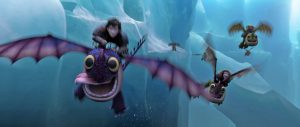

Worse still: the young dragons “who don’t listen to anyone”, which was made clear in the second movie, wouldn’t listen to anyone this time around as well. Would their parents “round them up”? It’s quite a stretch to imagine that happening, especially since a lot of dragons in the story apparently leave their young to their own devices, soon after learning to fly.
Where were all these young dragons, and what happened to them? In fact, even the young dragons (ridden in the previous movie) wouldn’t have “grown up” by the time of this final movie. The events of this final movie only play out about a year after those those of the second movie.
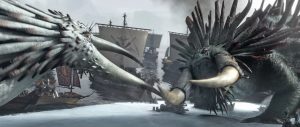

How would the Dragon Riders know that Toothless is the only alpha? In fact, there were several times throughout the HTTYD story when there was more than a single alpha dragon – they were just far apart and hidden.
Another alpha (or contender) could still be enslaved by humans (or hidden), and if it would ever get the message from another dragon to enter the Hidden World, would it simply follow those orders without a massive fight? Pretty doubtful.
Did the Hidden World not have an alpha this whole time? Who kept the peace there over the centuries? Wouldn’t Toothless again have had to fight terribly, to become the alpha there? The first time we see Toothless in the Hidden World, he’s already king with his Light Fury “queen” by his side – he was only gone for a couple of days at that point. Why was he simply accepted? None of this is explained.
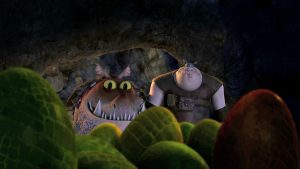

If Hiccup cared so much about the dragons, then why send away the only means of reaching and rescuing the dragons that are still trapped or otherwise enslaved?
It was made clear in the movie that there are many more hunters and trappers “out there”. By sending their only dragons away so hurriedly, the Dragon Riders have doomed all the currently enslaved dragons to a cruel death.
Previous episodes of the TV series have revealed the very likely scenario of massive breeding operations of trapped dragons going on. Trapped dragons could be bred indefinitely for meat, warfare, slavery or whatever reason, and now without any hope for rescue.
Hiccup on several occasions had shown how incredibly important it is to him not to cause dragons harm, even as fierce dragons (Singetails) were being ridden by ruthless trappers/hunters and bringing the Dragon Riders to near-defeat. Instead, with help of his friends, Hiccup had always managed to work out a way around the problem, towards a workable solution.
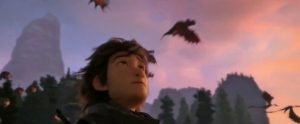

Toothless knows all of this as he’s been witness to it, and yet are we to believe that he’d ignore all of that so he could hide away in a hole in the ground with his new mate? He couldn’t rescue or probably even find those enslaved dragons on his own; the enslaved dragons are left to be forgotten, and with fewer dragons naturally around, the enslaved dragons and breeding programs would have become far more valuable and lucrative due to the lower supply of wild dragons to capture.
This would have made Hiccup’s problem even worse, now that he had no hope of rescuing them, having given up his only advantage – his benevolent command over flight, stealth and might.
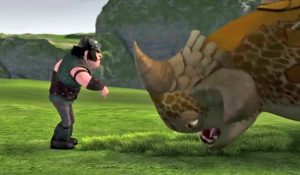

It’s clear there are several dragon species very well adapted to living on the surface, with some (such as the Buffalord) requiring a specific diet and environment to survive. The Timberjacks are highly adapted to living in forests, which are their homes. The Snaptrappers also live in forests and eat spiders and small land animals. Smothering Smokebreaths appear to require metal to weld together and build their nests with. Sandbusters appear to require beaches/sand, even using molten sand as their only observed firepower.
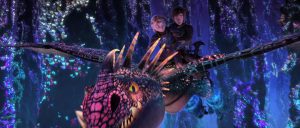

So, how will these specialised dragons fare and adapt when faced with a comparatively barren cavernous “cave” with no trees, grass, herbs, sand or wildlife? Probably not too great. Hiccup and the Dragon Riders would have been keenly aware of this.
The cave Hidden World is beautiful and shiny, but that doesn’t mean that dragons adapted to living on the surface can survive there.
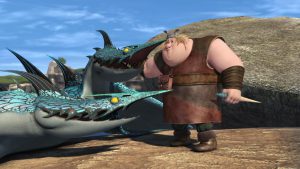

The drop down into the Hidden World is incredibly deep and rocky, so how would a flightless Seashocker dragon for example, survive crashing down into the bottom, at quite possibly terminal velocity?
How would Toothless even find and communicate to a sea dragon to drop down a hole beneath the seafloor, and if that hole is the ancestral home of all dragons then how did flightless/legless dragons ever manage to get out of it – clearly they evolved on the surface over a very long time.
Once again, would dropping them down a hole not alter their environment in ways which their adaptations couldn’t deal with?
Kids are taught about animal evolution and adaptations at a very early age, and would know something’s very amiss.


In the TV series these kinds of details were mulled over with excruciating detail.
The plot of the TV series, shorts and first and second movies was carefully planned and synchronised to not work against the other, but all of that groundwork and care had apparently been ignored for this movie.


The TV series (and short movies) were in the past officially treated as the story between the first movie and the second!
(Source, retrieved Jan. 5)
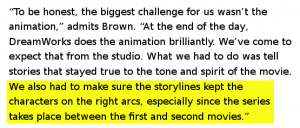





The
film[HTTYD – Race to the Edge Series] is both a prequel and sequel of sorts, set between the first and second film. The action picks up about a year before How to Train Your Dragon 2 when Hiccup is roughly 19 years old.Over the course of the series you’ll see plot points addressed that lead to the beginning of How to Train Your Dragon 2, like how Stoic gets his dragon and the developing relationship between Hiccup and Astrid. Conversely, the narrative designed for the show will be resolved in a way that leaves the Vikings of Berk exactly where the
cannon[canon] established part 2 picks up.The writers worked in tandem with the film series creator Dean Dublois to make sure they aren’t treading on any storylines or emotional beats he’s heading toward in the third film.
Source: Collider.com
Had this third movie been a “final” TV series episode, it would have been heavily criticised as completely out of place and weird, like a strange dream or like everyone had been drugged into a weak stupor.
(My feeling is, that if there’s anything that doesn’t belong to the overall story, then in fact it’s this “Hidden World” movie, but that’s something to discuss in a future blog post.)
Why did so many dragons (including the alpha Toothless) apparently not know of the Hidden World?
They likely hatched on the surface, but don’t they communicate information between each other? Even “real” and less intelligent animals in our world communicate vital information between each other. Most dragons in this story overall, were highly intelligent and even capable of understanding human language.
The Hidden World is supposed to be the ancestral home of all dragons, after all – clearly an important place.
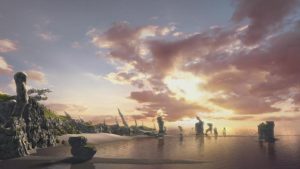

On the surface, it seemed that pretty much every dragon knew of the hidden island “Vanaheim” where almost all dragons go to die, as revealed in the TV series.
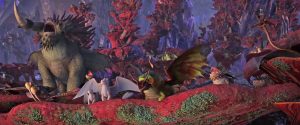

We see the massive alpha that was defeated in the second movie by Toothless, living inside the Hidden World – how did he get down there without getting splattered like a watermelon across the rocks at the bottom?
Did that alpha beat up the other unseen alpha that was there, and then hand the reigns over to Toothless?
The defeated alpha is simply “there”, but what does that actually mean? The movie’s makers explaining such things in interviews and DVD commentary, after the movie was shown in theaters, doesn’t count. Most people who watch the movie, won’t look for interviews or DVD commentary to try and fill in plot holes.
These kinds of things need to be addressed in the movie, if only in a passing comment by one of the characters.
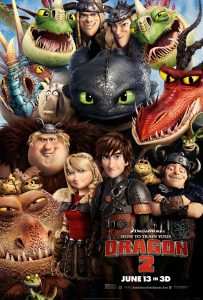

At no point were any viable alternatives to sending their own dragons away raised by any of the other Dragon Riders: not even “Snotlout”, who would have been itching to decisively fly into any battle from his testosterone-fueled bravado and the “Thorston” twins out of sheer unthinking gung-ho.
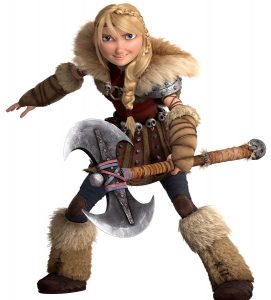

Fishlegs had none of his usual dragon smarts or intelligent reasoning in this movie, and Astrid is a fierce fighter that never backs down or gives up an inch.
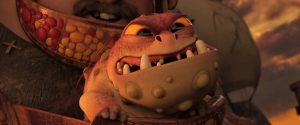

In fact, Fishlegs would have shrieked and screamed with horror at the sight of these plot holes, as well as the thought of bringing a baby dragon into a dangerous battle – the responsible Fishlegs “we knew” would never have acted this way.
It seems all the other Dragon Riders were intentionally dumbed-down and made ineffective, to allow the alien subplot to take over – they hardly had any lines or proper interaction usually expected of teammates.
There was a lot of unusual “flirtation and fawning” going on between the characters, seemingly to help replace the real intelligence of before. In the second movie, this particular element was already there, but explained by “youthful hormones” – although it was still laid on a little crudely and thick at times.
However, this movie turns all that up to yet another level. Almost everyone suddenly gets themselves a love-interest, no matter how farfetched and unlikely the pairing. This seemed a lot like a “move” often seen in low quality fanfiction, to either help keep the story dragging on or bring it to an exhausted and tired end.
Preoccupation with fanciful “hanky-panky” has traditionally been a viable alternative to character development and intelligence.
When the intended audience of a movie is so young, it seems especially crass to make it such an obvious but also insincere element of the story.
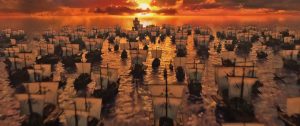

What happened with the incredibly frowny – and therefore dangerous – warlords with their massive armada of hundreds of heavily armed ships? Even if the warlords had died, the armada had not been destroyed, and so could and would have laid waste to anything that attacked them.
Sending the dragons away – the only means of defending the Berkians – would have been complete suicide. It would have been like throwing all weapons, bows, arrows, guns, bullets, cannons, flamethrowers, tanks, submarines, fighter planes and missiles into the sea with an angry and bloodthirsty armada at their doorstep, and then expecting the armada to leave because the Dragon Riders have now disarmed themselves.
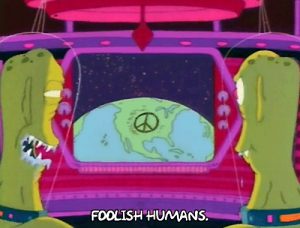

Nobody would have disarmed themselves like that, unless they wanted to be completely annihilated. Even without having seen the previous movies and TV series, this whole story simply wouldn’t have made any sense. Even if the dragons hadn’t been ordered to fight and defend, they could have been used as a means of escape and deception, or calculated dismantling of the enemy’s forces without direct conflict.
The Brain Slug-free Berkians had already proven that they’re able to gain a tactical advantage, work on a clever plan – and to enact one.
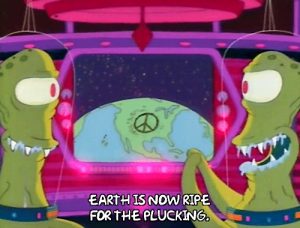

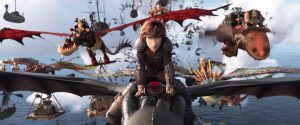

However, the uncharacteristically knee-jerk decision to leave Berk for a place not known to exist came as a surprise. Especially after the loud and certain agreement by Hiccup and all its residents, that they were stronger as a result of their new friendship with dragons, and frequently had this strength tested with a multitude of amazingly powerful enemies.
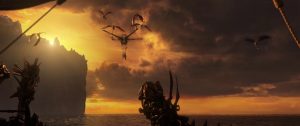

Grimmel only had six or so killer dragons under his command; Hiccup had the one of the world’s most powerful armies, that would have easily pounded even the most vicious of dragons into paste, or at least threatened to or just subdue them.
Hiccup and the dragons already did this in the second movie, and now many more mighty dragons had joined their side – thousands more!
Hiccup and Toothless had enough dragons to protect each other as well as defeat an enemy: this would produce a much lower risk than Hiccup’s many previous missions with only the Dragon Riders’ five dragons.
Strength and safety, in numbers and unity! It’s a proven survival tactic in nature, as old as life itself. Aristotle even wrote about it, around 350BC. (Source)
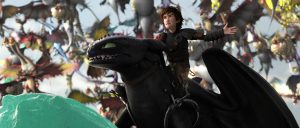

In fact, in the TV series, the Dragon Riders used sentinel and tracking dragons to monitor their island. Where were these or any such dragons in this movie?
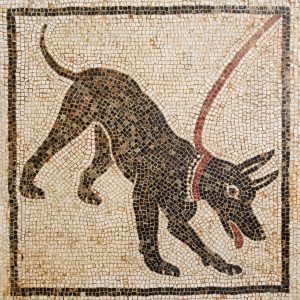

Would it be ridiculous to suggest rotating a team of bodyguard dragons near Toothless?
A lot of powerful dragons would have been more than honoured to protect their alpha.
Humans have used “guard dogs” and “war dogs” for thousands of years – it’s not exactly a new invention. (Source 1, Source 2, retrieved Jan 5.)
This kind of thing simply isn’t forgotten, but in this movie it apparently was, and with very little resistance. (Mind-bending aliens and their creeping subplots, yet again! Brain Slugs? Perhaps it was indeed Brain Slugs – it’s possible!!)
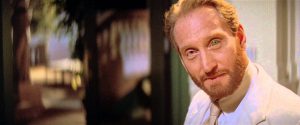

Worse still: Like in many classic “good vs. evil” stories, Grimmel (The Very-Evil) completely laid out his plans to Hiccup – as well as the means of achieving them and the method of controlling his killer “Deathgripper” dragons… but without apparent disadvantage to the execution of his evil plans.
This “just between you and me” trope is something straight from almost every James Bond and Disney villain. (I thought that DreamWorks Animation made fun of other stories for relying on such tropes, and now they’re doing it themselves!)
The Hiccup of the previous movie and TV series, would have easily used the new information to his advantage, and completely deactivated Grimmel’s ability to control his killer dragons!
It actually wouldn’t have been so difficult to free the Deathgripper dragons from Grimmel’s control; the Hiccup of before would have smugly enjoyed freeing the dragons, and cleverly succeeded, even with tactics he’s already used in other situations.
Hiccup even wouldn’t have had to come up with any new amazing plans! Small and agile trained dragons (such as Terrible or Night Terrors) as already used in the TV series, could have easily deactivated Grimmel’s control – I won’t spoil what, but the small agile dragons could have “taken” something off the Deathgrippers.
While Grimmel’s reason for killing every Night Fury dragon (except Toothless) wasn’t especially compelling (psycopaths like Grimmel and Scaramanga don’t need a good reason, so we’ll let that slide), his method of actually getting close enough to them doesn’t make much sense.
Without me spoiling things too much now, you’ll notice when you discover his quite devious method, that he directly contradicts himself by saying that Night Furies mate for life, which he even counts on for his method to work. Even then, Night Furies and other dragons appear to have a long lifespan similar to humans; it would have been impossible for such a method to help find every Night Fury to kill, in the lifespan of a single human such as Grimmel.
(Was there another method to find and lure the highly elusive and Dangerous Night Furies mentioned in the movie? If yes, then I missed it and this paragraph needs correcting.)
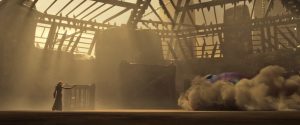

In the trailer, we see a charging Rumblehorn instantly taken down by a single shot of Grimmel’s weapon. Firstly, these dragons are armoured like a tank, but let’s go nuts and assume a weak spot was found on a rampaging tank (Scaramanga’s nearly impossible single-shot kill) – there’s no way to disable the nervous system of any creature, especially that big, so quickly with the kind of weapon he used.
The only thing which could instantly disrupt the entire nervous system is direct and very powerful internal electrical disruption, and judging by the way his weapon was described and seen to work, it’s unlikely to have had some kind of electrical element to it. Haven’t viewers seen too many unlikely movie scenarios by now, where a single shot instantly kills or disables the victim or attacker?
It seems lazy not to come up with a more realistic scenario… even in a fairytale.
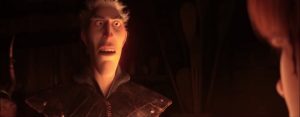

While on the subject of unlikely, there is something even more unlikely: Grimmel infiltrating Berk with his (very large) killer dragons, him silently breaking in and casually sitting inside Hiccup’s own home, and all without being detected by any other dragon on Berk!
Even the laziest of guard dogs would have gone nuts at such an obvious intrusion.
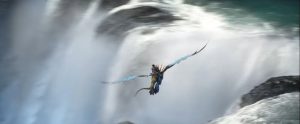

Berk was absolutely crawling with all kinds of tracker dragons – Stormfly, Astrid’s Deadly Nadder dragon, was able to track Toothless to the Hidden World long after he had gone there (to the point of wondering how on earth she even managed to do that).
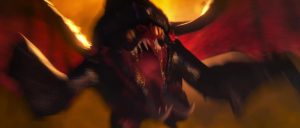

Grimmel and his killer dragons – natural enemies of other dragons – would have stood out like a thousand sore thumbs and caused the dragons on Berk to immediately attack or at least raise the alarm. Instead though, everyone was caught completely unawares and allowed their village to be burned to the ground. They even had warning of an attack, and time to prepare!
There is no explanation for something that makes this little sense, and is in complete contrast to anything seen before.
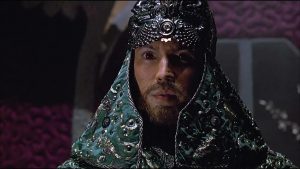

Not even “Shiwan Khan” from “The Shadow” could have pulled off such an amazing feat of mass-hypnosis, and apparently he was the last survivor of Genghis Khan and telepathic! In the 1994 movie “The Shadow”, Khan managed to hypnotize an entire city to no longer see a massive hotel building, and dismiss it from peoples’ memory.
The only thing that could hypnotize a Terrible Terror or Deadly Nadder dragon (besides a Bewilderbeast) is a laser pointer and fat chicken drumstick, respectively.
Looking at this story from a distance, and its skewered alien subplot that had to work at any expense, something does begin to stand out:
This nonsensical event of Grimmel and his massive Deathgrippers remaining undetected, had to take place to kick off Hiccup’s similarly nonsensical decision to escape from Berk to go into hiding inside a place not even known to exist.
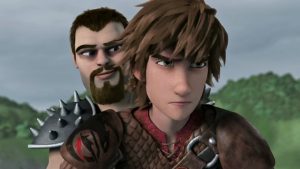

While this movie’s main villain Grimmel is frightening due to his high intelligence and cunning, it’s not something the Dragon Riders haven’t conquered before.
The only frightening and remotely new enemy in fact is the outside world closing in on them even more than ever; increasingly ruthless outsiders learning of the dragons and wanting them for their own selfish gains. Although, we’ve witnessed that in the previous movie and TV series as well.
The enemy they faced in this movie wasn’t all that new. Actually, the enemy wasn’t even that unbeatable – either with direct conflict or with deception. The enemy was slow and cumbersome: lazy ships versus incredible speeding and mighty dragons.
The Dragon Riders in this movie apparently needed to be weakened and dumbed-down with overpowering preoccupations for “hanky-panky” and a weak resolve, in order for this enemy to seem strong enough – even Grimmel himself in the story found this behaviour by the Dragon Riders to be amusing. (Yet another lazy trope/tactic knows as “lampshading”, used by writers/politicians/etc. to brush off unusual plot developments by calling attention to them and then simply moving on.)
Let’s also not forget that dragons are in no way defenseless, and that even a tiny Terrible Terror could overpower a human being. The dragons could make mincemeat of the humans if they wanted to, and in a moment of inter-world intolerance we saw that almost happening to the humans, who for a few short moments were inside the Hidden World and were violently attacked.
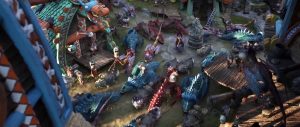

It’s clear that Hiccup is (mostly) a pacifist and never wanted to have a war, and realised that he had made a mistake by bringing so many dragons so closely together on a single place – his home island of Berk.
This put a target on Berk’s back, which however would have been a problem with still many possible and workable solutions. None of these workable solutions were entertained, and to fill in this gaping hole, a single harebrained and panicked solution was chosen.
Does this sound like the incredibly resourceful, bright and dedicated Hiccup from the previous movies?
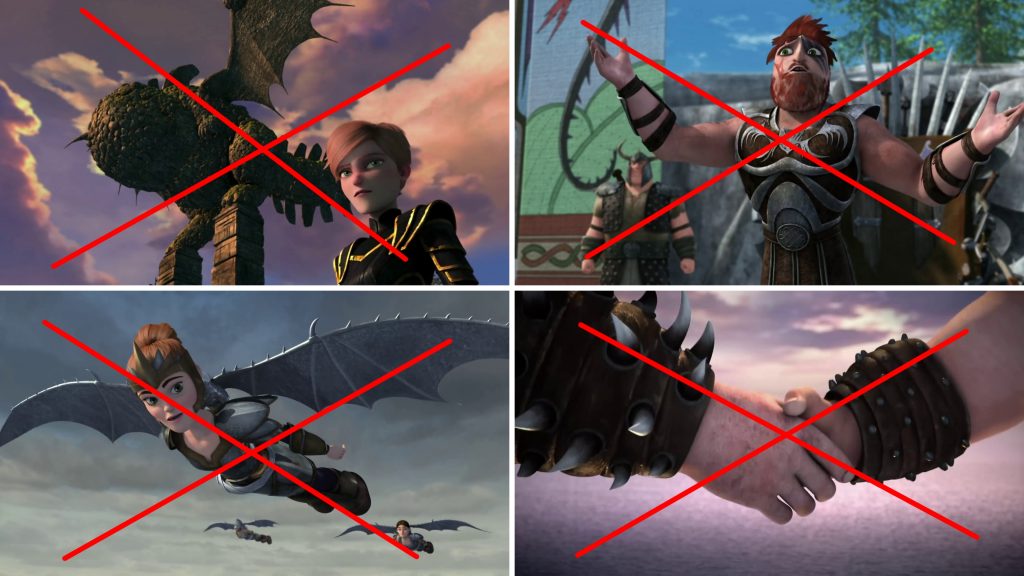

Because the TV series, shorts and movies tied in so well together, it was quite a bold move to seemingly erase out all of the allies the Dragon Riders had made over the course of the whole story. This is just another example of forcing an alien subplot to work out somehow, at any cost.
What happened to the Defenders of the Wing, who completely relied on their Eruptodon dragon to prevent their island from being destroyed, and in all likelihood getting killed themselves? They have based their whole myths and being around the Eruptodon dragon, and the welfare of all dragons. What kind of Hiccup and Toothless would have allowed their island’s destruction and likely death, and in fact actually cause it?!
The Wingmaidens are solely responsible for preventing the Razorwhip dragons’ extinction. Would the Razorwhips die out when put inside the Hidden world? According to the official story, it is highly likely!
What about all of the other allies such as the Berserkers or even Outcasts, who would have helped in any way they could?
*Poof, gone, never existed – all of them.*


Vanaheim, the mysterious and incredibly important island where dragons go to die – did all the dragons along with the extremely powerful and specifically adapted sentinel dragons just give that up as well?
Don’t forget, that the TV series was always officially the story between the first movie and the second movie. Now it seems that it never even happened.
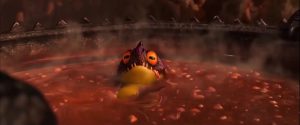

Finally, it must be mentioned that it did seem out of character for Hiccup and the Dragon Riders to try and mix dragons with Berk’s residents so closely in the final movie, to the point of dragons bathing in the soup cauldron!
This was probably skewed into the story, in order to make Hiccup’s predicament seem more unsustainable, so that future uncharacteristic behaviour will look less out of place.
(Were the clownish Hobgobbler dragons, like the one in the soup cauldron, created and used as a primitive plot device to distract from all of this movie’s unusual character changes and situations?)
As mentioned before: there are several dragon species known to be completely incompatible with each other and anywhere outside their current environment, and therefore would have been excluded from Berk – not exactly a utopia for all dragons, then.
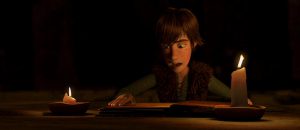

In the first HTTYD movie, we can see Hiccup go through the “Dragon Manual/Book of Dragons” (the Viking encyclopedia of all dragons known to the Berkians). In the Dragon Manual, there are several dragons known to be hostile to one another, or simply highly specialised and reclusive, or untrainable. Hiccup and the Dragon Riders knew from the very beginning that it’s impossible to put so many dragons in the one place – not improbable, but impossible!
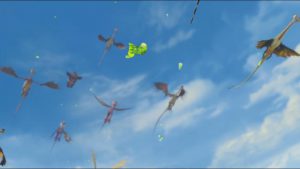

In the TV series, the first episode already showed how problematic the new friendship with dragons is, and the then 15 year old Dragon Riders ended up creating realistic and clever solutions – and they certainly didn’t involve packing the dragons and villagers even closer together.
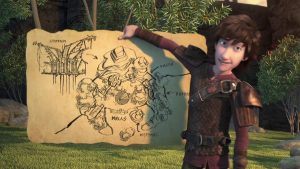

Had everyone’s character remained un-mangled or free from influence of Brain Slugs, then Hiccup and “There is no greater treasure than knowledge!” Fishlegs would have been the first to work out a better solution. Not only to safely allow dragons on several surrounding islands in the archipelago, but also keep them guarded and protected, as well as have several planned out escape routes and techniques in place.
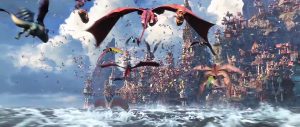

Even if the entire TV series hadn’t happened, are we to believe that someone as brilliant, experienced and dedicated as Hiccup and Fishlegs (or the whole team) wouldn’t have been able to come up with an elegant and sustainable solution to the dragon housing problem?
This kind of problem would never have happened to the “normal” Dragon Riders of the previous movies, in the first place.
The Dragon Riders would never have allowed things to get as bad, as they had in the HTTYD: The Hidden World movie.
That’s all I could think of in one go, and personally don’t really want to go into greater detail, although there are almost certainly more of these plot holes and weaknesses thanks to the alien subplot of doom that was skewered in and then took over. Have you noticed any more yourself?
(End of possible spoilers)
Giving up
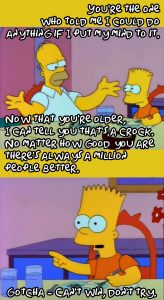

While frequently touted as a “coming of age” story (Source 1, Source 2.), one that teaches to put away childish beliefs and things in view of the future, what does “coming of age” actually mean in this particular story? In the end, the moral of the story appears to come uncomfortably close, to being that growing up means accepting that one’s own world is smaller and less controllable than you first thought when younger.
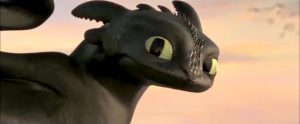

That even as a leader of those immediately around you (family, tribe, pets, etc.), it’s better to not stand out too much and therefore give up some of the things truly close to your heart and very being (such as family, history, legacy, identity, homeland), so that you don’t have even more taken from you (your life) by those bigger or more ruthless than yourself.
Hiccup, and also Toothless hastily decided to separate completely and forever, instead of learning and building on their significant and growing experience, strengths and achievements.
It’s never easy to keep going forward like this, but Hiccup and Toothless had already proven themselves in the past, many times over! All of the Dragon Riders had proven themselves – they were capable.
Even if they had to compromise or separate in the future – the journey to this conclusion would not have been made from making mistakes and giving up like they did in this movie, but rather making mistakes and trying their very best to learn from them as a team, family and tribe.
All of the Dragon Riders and their dragon-friends had done this with overall success, for the last six years of their lives.
Were the Dragon Riders and all of the Berkians genetically predestined to fail and give up, despite their incredible achievements? Were the dragons only there for the free fish and scale exfoliation, after all?
There does come a point, where human DNA simply puts too many limits and difficulties upon the idealistic attempts to exceed one’s own limits, for the greater good. It’s important to never stop trying, though.
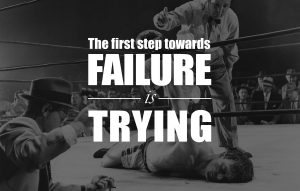

Even though millions of children in daycare centers and oppressive schools and families around the world will grow up to believe that keeping their heads down is a reasonable thing to do, it doesn’t sound like the right lesson to learn when growing up. It especially doesn’t sound like the right kind of story to tell children.
This is however, where the skewered and overpowering “alien subplot” seems to be heading. Unfortunately, it’s far out of touch with what the previous HTTYD movies and TV series have taught. What then is its purpose? Is it to teach something that’s supposedly “realistic”, or be so out of touch with human nature that it gets rejected and the opposite is done with even greater energy?
Viking and Norse wisdom, and how it could have been applied:
“The brave man well shall fight and win, though dull his blade may be.”
― Fáfnir’s sayings
(Courage and perseverance can and will win, even when you’re not as strong or well-equipped as others.)
“He knows most who most has tried.”
― The Saga of Grettir the Strong
(Learning and wisdom comes from experience, and even failure.)
“Not every cloud which darkens the day brings rain.”
― The Saga of the Heath-Slayings
(Hard times will happen, but may not be as bad as expected.)
“Luck accompanies wisdom.”
― The Saga of Olaf Haraldsson
(Success often comes from learning and knowledge.)
“Long is it remembered what youth has gained.”
― The Tale of Gunnlaug the Worm-tongue and Raven the Skald
(Lessons learned in youth, good or bad, will leave their mark and can benefit you in later life. Never stop learning.)
Instead of “giving up” and (sarcastically) calling it “coming of age” like this movie has, it could have been “perservering” and “learning from experience”.
The Berkians in this story, had shown no shortage of “perseverance and learning from experience” in their past – especially their recent past, ever since Hiccup befriended the dragon Toothless.
Therefore, this movie’s story could easily have explored all problems the Berkians were facing, from the perspective of true tenacity and growing wisdom: Rolling with the punches, and the light at the end of the tunnel in sight – even when the paths split at the end of their journey.
The Berkians had a lot to live for, a lot to fight for, and a whole lot of history to back them up – they didn’t need anyone to speak for them. Greatness has a habit of causing greater problems, but they are a better quality of problems, setting the stage for even greater challenges and victories.
How awesome a sight it would have been, to witness the Berkians and dragons overcome Grimmel’s lowly but confronting challenge from a place of even greater experience and tenacity. Then on their own terms, decide on a sensible separation on the back of their greatness, rather than the artificially-manufactured pit of desperation and self-interest as seen in this movie.
A goodbye can still be necessary but sweet, when coming from a place of shared greatness, and the Berkians and dragons had achieved that in the previous movies/TV series.
Whether in the pit of desperation or on the back of greatness, one still feels the losses and pains of losing a friend – it would still have been an emotional ending.
The now modern, sensitive and benevolent Lion King only eats Entovegan!
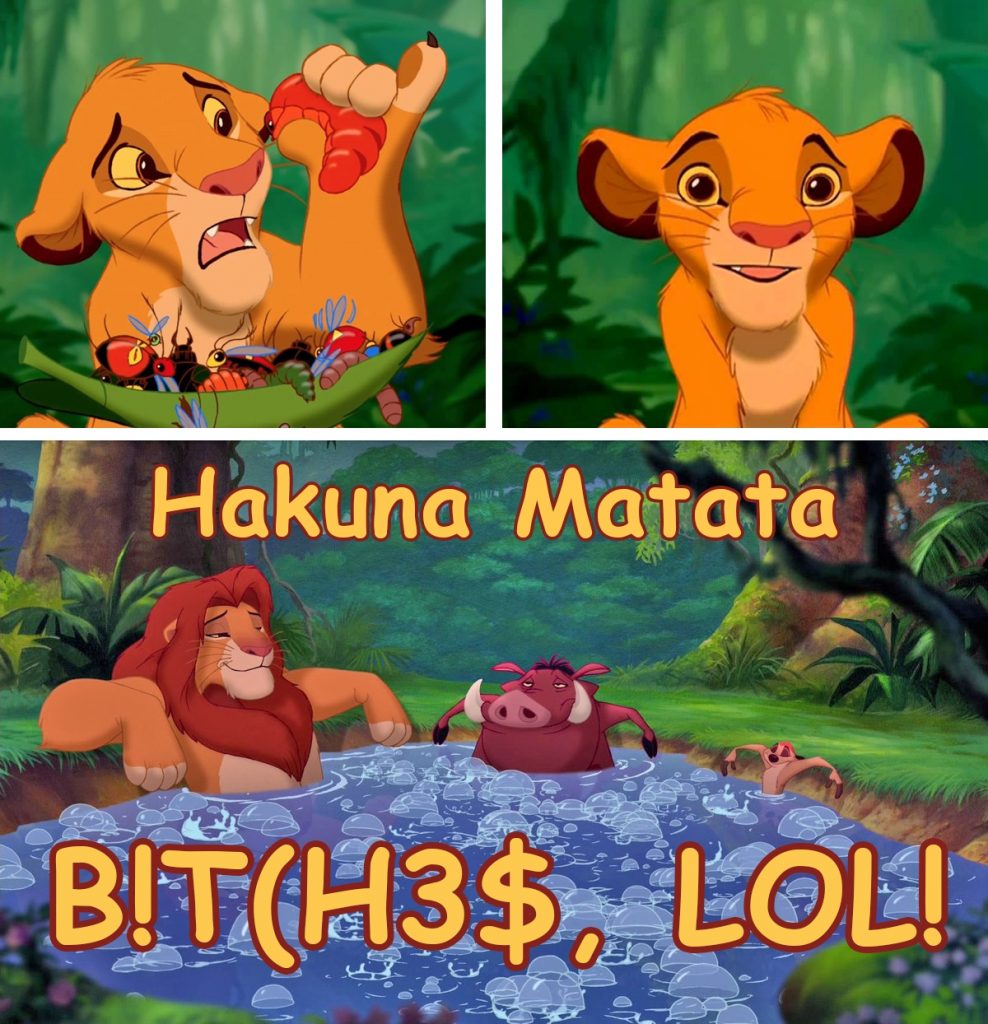

Disney’s 1994 smash hit animated movie “The Lion King” would have ended very differently had Simba decided that Hakuna Matata (“Look, sometimes bad things happen and there’s nothing you can do about it. So why worry?”) is a worthy alternative to toughening and smarting up and driving out the enemies and invaders of one’s homeland, even at great cost and danger – the good and the right is worth fighting for, after all.
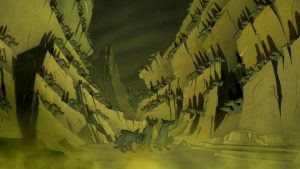

The hyenas aren’t comparable to the dragons in this story; the hyenas are the constant incompatible outside threat, to the harmonious utopia and balance that the Lion King had managed to achieve amongst all of the creatures on his land.
Hiccup had also achieved a more-or-less harmonious balance, or was very close to getting there, but after the “hyenas'” latest attack instead decided it would be better to immediately and permanently send away the creatures that had now been living peacefully in his kingdom in order to stop future outside attacks, and just leave it at that and expect the best.
That would be a bit like Simba quietly trying to convince the antelope and zebras to migrate elsewhere, away from his kingdom, so it wouldn’t be as attractive anymore to the current intruders. He would wait until the intruders leave and then walk in and order his pride to start eating beetles and grubs instead, just like he did.
Is accepting defeat and loss of one’s own closely-held values, strengths and identity an acceptable alternative to conflict? Apparently, according to this final chapter of the How to Train Your Dragon story – yes, it is.
What a downer.
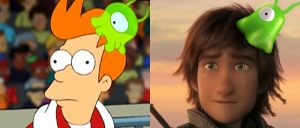

Once again: even if the realistic solution would have been to ultimately send the dragons to the Hidden World, the Brain Slug-free Dragon Riders of the past would have done it in a different way, true to their personalities and experience, and in fact true to the entire story up to this point.
Viking and Norse wisdom, and how it could have been applied:
“Fight your foes in the field, nor be burnt in your house.”
― The Saga of the Volsungs
(Confront your challenges, rather than running from them and having them find you unprepared.)
As sure as the sky is blue, the Berkians definitely did not do this in this third “Hidden World” movie, and if you’ve seen the movie, you know what happened!
“Ill is the result of letting fear rule thine actions.”
― The Saga of Harald Hardrada (Hard Ruler)
(You make foolish mistakes when overcome by fear. Don’t allow emotion to cloud your judgment.)
“A man should have his plans worked out before he enters into great undertakings or incites others to them.”
― The Saga of Ref (‘Fox’) the Sly
(Be responsible when making big decisions, make sure they are well considered and planned – especially when you involve those around you.)
“A person should not agree today to what they’ll regret tomorrow.”
― The Saga of the Confederates
(Consider your decisions carefully and not in the heat of the moment, think of how your choices will affect your future.)
“With many who come to power and honor, pride keeps pace with promotion.”
― The Saga of Magnus the Good
(Achieving more influence and esteem, raises one’s sense of worth and importance.)
“Often times it is not numbers that wins the victory, but those who fare forward with the most vigor.”
― The Saga of Thrond of Gate
(Don’t be overwhelmed by the size of the challenge, the purpose and certainty of the few often wins over the lesser masses.)
“The coward believes he will live forever if he holds back in the battle. But in old age he shall have no peace. Though spears have spared his limbs.”
― The Hávamál
(Those afraid to live their lives to the full, will regret it when they are old and look back upon the opportunities missed. The inner turmoil and pain of this is more severe, than the battle scars of the honourable and brave.)
“Bravery is half the victory.”
― The Saga of Harald Hardrada (Hard Ruler)
(Overcoming one’s fears, is already half the achievement – one will be well on their way towards success.)
“Better to fight and fall than to live without hope.”
― The Saga of the Volsungs
(Fight for your cause, as there is no greater death and suffering than hopelessness.)
“Eagles should show their claws, though dying.”
― The Saga of Olaf Haraldsson (The Big)
(No matter how difficult the situation, stay strong and be true to who you are.)
“Many are wise after the event.”
― The Saga of the People of Fljótsdalur
(There is clarity in hindsight, learn from history and don’t repeat its mistakes.)
The Vikings knew a lot about the serious and terrible (long-term) consequences of giving up one’s homeland – you could say they had a lot of first-hand experience! After all, they certainly witnessed the destruction of their conquests over other lands, and listened to the tales of such conquests when growing up.
It would have been unthinkable for any Viking (or Norseman) to give in to anything negative, that they themselves have done to others, or give up the spoils they have shared amongst themselves.
The Berkians may not have been the wild conquerers and plunderers that some of their neighbours likely were, but they certainly knew the destructive effects of giving up and losing one’s homeland, and also losing one’s values, strenghts and identity/ancestry.
So, with the above in mind, and fleeing from one’s homeland not an option, what other options did the Berkians have? Well, they had plenty:
Firstly, it should be mentioned once again, that the Berkians-uninfluenced-by-aliens-or-Brain-Slugs would never have allowed their situation on Berk to become as bad as it had, before they were spooked into leaving.
However, even if they had “allowed” the bad situation and resulting attack, it would have been a mere wake-up call for them to get their act together.
After the attack, the Berkians could have hidden the weaker dragons and formed defensive perimeters around their island, sent out scout dragons to track down Grimmel and then spy on him the way he clearly did to the Berkians, in order to find out his weaknesses. Those weaknesses were so ludicrously easy to discover and exploit (removing his control over his dragons), it would have ended the final battle with him before it really begun.
The armada could have been outrun indefinitely, but sabotaging their weaponry and even food/water supplies with specially trained dragons at night, would have crippled them quickly and without direct conflict. Hiccup had thousands of clever dragons at his command, and he’s trained such dragons brilliantly before.
A more direct approach would have been luring the armada away from Berk, and setting every single ship aflame in a surprise attack, all at once. Massive sea dragons alone, could have made light work of even such a powerful armada – they were wooden, breakable and flammable intruders in the sea dragons’ domain.
Stoick’s battle ships lasted three seconds against the might of the Red Death dragon in the first movie – a thousand big dragons, all under Hiccup’s command, equal a lot more firepower than just one massive Red Death dragon.
Grimmel and his six dragons could have been hunted down and crushed like cockroaches trapped in a slippery kitchen sink basin, with Toothless safely guarded on Berk and Hiccup flying another dragon, along with an incredible army of the fiercest dragons that he had command over.
However, Hiccup generally didn’t like full on military-style attacks, so he could have further enhanced his deception and indirect conflict advantages by once again using Dragon’s Edge – the island that he and the Dragon Riders had claimed and fortified in the TV series, and bringing in the old friends he had made over the years to assist.
These friends were themselves a mighty force to be reckoned with, and they too were able to work together with dragons to become stronger. Any deception or indirect conflict could very well have completely dismantled Grimmel and his armada, without any human and dragon casualties.
Old friends uniting, coming together in a bloodless battle of intelligence, values and idealism, for what is good and right – it would have been interesting to see, and very possible within the storyline as well. Coming to terms with the fact that humans and dragons still need to live apart, could have been done as a joint decision of every dragon-friendly tribe, and carried out with intelligence and pride.
Vikings never fought battles again after booting out the dragons, and the dragons were safe from harm… or were they?
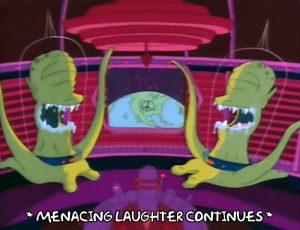

It’s not like Vikings wouldn’t get attacked by outside forces, for other reasons too – especially now that skilled hunters who enjoyed killing dragons for sport and profit suddenly have a whole lot of spare time and no other skills.
The hunters won’t take up knitting and helping old ladies pick fruit and mushrooms: perhaps they’ll just turn their attention to laying waste to other humans who can’t defend themselves, instead. Wouldn’t savage and remorseless dragon hunters who were made completely redundant by Hiccup and his tribe, seek bloody vengeance?
The dragon hunters and warlords would have known that Hiccup sent the dragons away, and that chief-Hiccup’s home island of Berk is no longer effectively defended (and that any remaining wild dragons could not be protected, by dragon-less Dragon Riders).
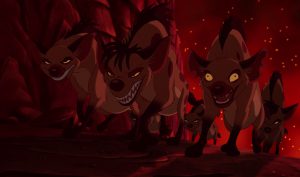

Hunters, warlords (and Vikings) aren’t known for their benevolence, hospitality and respect of borders. However with their livelihood threatened, they have also spent years, strengthening their own weapons and nursing their grudges against the Dragon Riders.
The hyenas from the Lion King took over the Pride Lands, the moment its powerful protector (Mufasa) was out of the picture.
Any unscrupulous enemy like this would do such a thing.
As for the safety of the dragons – it’s not like they don’t also mangle, kill and eat each other simply to survive (or for other reasons)… Evolution: you can’t prevent it, just because it’s mean sometimes, and let’s not go down the scary rabbit hole of leaders “forcing” it.
Rescuing dragons from hunters and offering the hunters and their communities more productive alternatives over time, could also have been a long-term solution and allowed the hunters to grow themselves. Otherwise, they’d have to face the self-destructive results of their own irrelevance, as the rest of their world moved on.
One can’t go down a particular rabbit hole, by making dragons into friends, then decide it’s too difficult and magically pop up on the surface as if nothing had happened.
The lives of the Isle of Berk’s dragon-friendly inhabitants and the world around them, had changed forever – impossible to simply undo as this story had tried to, but ended up falling all over itself in the process instead.
Viking and Norse wisdom, and how it could have been applied:
“The longer the vengeance is drawn out, the more satisfying it will be.”
― The Saga of the People of Ljósavatn
(Bide your time, make your plans, strengthen your weapons and watch as your enemy slowly suffers.)
This is what the dragon hunters and warlords will be doing with their spare time, as they slowly start squeezing every exquisite ounce of earthly existence from the Berkians’ squirming, pathetic, now outgunned living corpses.
“It is their lot who stand with the great that they enjoy high honors, and are more respected than others, but stand often in danger of their lives.”
― The Saga of Olaf Haraldsson (The Big)
(The taller you are, the greater target you become.)
“One’s back is vulnerable, unless one has a brother.”
― The Saga of Grettir the Strong
(Look after your friends and allies, and they will look after you – you are stronger together.)
“When faring on journeys, ward yourself well. Take not harbor near the highway for thereby dwell many ill wights for men’s bewilderment.”
― The Saga of the Volsungs
(When away from home you are exposed, so be cautious, look after yourself and be mindful of new dangers.)
“Trust not him whose father, brother or other kin you have slain no matter how young he be, for often grows the wolf in the child.”
― The Saga of the Volsungs
(Those you have hurt even indirectly, are likely to seek vengeance still, and can rarely be trusted.)
“Who can’t defend the wealth they have must die, or share with the rover bold.”
― The Saga of Olaf Haraldsson (The Big)
(Those who can’t protect what’s theirs, will have it taken from them one way or another.)
“Never walk away from home ahead of your axe and sword. You can’t feel a battle in your bones or foresee a fight.”
― The Hávamál
(Don’t let your guard down outside your home, prepare for the unexpected, as you can’t predict the world outside your own.)
“All things happen in threes.”
― The Saga of Grettir the Strong
(Bad things have a way of coming together, so don’t be complacent by expecting only the one.)
“The fire seems hottest to a burned man.”
― The Saga of Grettir the Strong
(Emotional scars never fully heal, and add to future pain.)
“The cattle are like their master.”
― The Saga of Víga-Glúm
(Those with influence grow followers, so be a responsible leader.)
“That which has a bad beginning, is likely to have a bad ending.”
― The Saga of Hen-Thorir
(Plan your undertakings with care and make a good start, because starting out badly is unlikely to turn out well.)
“The run of the game is decided by the first move.”
― The Saga of the Foster-Brothers
(When engaged with the enemy, it is your first decision that decides your outcome. Make sure it is the correct one.)
When people hate you, and you are without home and friends, then things certainly start looking bleaker. For survival, you’ll need to start relying on the wisdom of the hunted, rather than the hunter. Certainly not a good place to be, and always best avoided.
The decisions that lead to you becoming the hunted often start out early in the journey, and are very difficult to correct later – you may need all the help you can get.
The Berkians had found themselves in a wretched situation, after making a series of mistakes and ignoring their own good strengths and experience. Sending away the dragons as some kind of solution while in such a poorly and delirious state, was indeed a very dangerous decision – one that would haunt them for the rest of their lives, and those of their descendants.
They could have sent the dragons away, after undoing the damage they had caused themselves with their previous bad decisions – the dragons could have, and indeed should have helped the Berkians do this. The dragons owed the Berkians – not the other way around.
Friendship always goes both ways.
A wasted opportunity for positive change
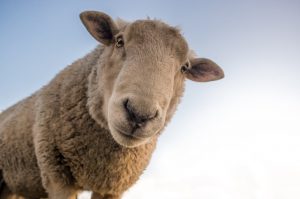

In fact, had such a gentle approach not worked, Hiccup had an entire army of the mightiest dragons at his disposal thanks to his positive lifelong efforts and values.
They were not to fight in a destructive way, but to enforce a simple rule by show of might and solidarity: say that he’s the leader and protector of the dragons now, that the hunting business is closed without exception, but that there’s a whole array of related and unrelated positive ventures and treaties to take part in.
Vikings were highly skilled and experienced traders and craftspeople – it wouldn’t have been so unusual to think that a now unprofitable venture could be traded up to a profitable one.
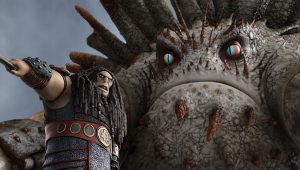

The enemy in this movie was made more complicated than just hunters though: there were powerful lunatics/warlords involved who wanted the dragons purely as weapons. Therefore, even if skilful trade could not have worked, then playing a trick on the rest of the world (as mentioned earlier), such as hiding the dragons (those which can safely be hidden) after pretending to send them all away, could have been a viable alternative.
However, such a positive act of leadership and brilliance wouldn’t have fit with this story’s disappointing alien subplot. It seems that the subplot of accepting defeat and giving away one’s own strengths, values and identity had to come to the fore, so any other intelligent alternatives were never used. The Berkians and Dragons were suddenly too helpless, to know or act any differently.
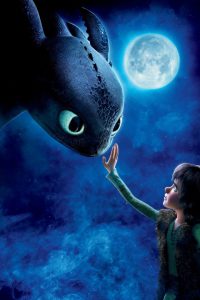

Had the first movie started out with a more uncertain moral message, then the way the story’s increasingly distracted and haphazard path and finite conclusion had been handled would not have earned such a level of scrutiny.
To be fair: it was clear that Hiccup’s current situation was unsustainable, but growing up and coming of age is not a good reason to quit, when things (good or bad) get unsustainable; growing up and learning even more (despite the hardships) is the correct solution, and the one that the Hiccup from earlier times would have chosen.
Viking and Norse wisdom, and how it could have been applied:
“Best it is, for man’s words to seek peace when it is possible.”
― The Saga of the Heath-Slayings
(Always try to resolve conflict peacefully, first.)
“Likely is ill the result when words of slander fly.”
― The Saga of the Heath-Slayings
(Careless things said in the heat of the moment often lead to more serious consequences.)
“Alone is it seemly to hold truly to troth given.”
― The Saga of the Volsungs
(It can be lonely doing the right thing. Expect this, and keep to your convictions regardless.)
“The common always love what is new.”
― The Saga of Olaf Haraldsson (The Big)
(Distance yourself from the crowd’s hype over new things. Be aware of the “brainwashing” power that anything new can have over people. Make up your own mind.)
It’s almost like the Vikings had witnessed people stand in line for 5 days to buy a new model iPhone. Hopefully you’ve never done anything like this, or are at least wiser now.
“Forethought is better than afterthought.”
― The Saga of the People of Vatnsdal
(Plan ahead, rather than waste effort fixing the mistakes or suffering the consequences of rash decisions.)
“There are few more certain tokens of ill than not to know how to accept the good.”
― The Saga of Grettir the Strong
(Becoming unable to see the good when it happens or is offered to you, will almost certainly lead to your misfortune and harm.)
“Nothing venture, nothing gain.”
― The Saga of Burnt Njáll
― The Saga of Hrafnkel the priest of Frey
(To make your goals come true, you need to put in the effort and risks, or achieve nothing.)
“Pride and wrong often end badly.”
― The Saga of Víga-Glúm
(Humbleness and good intentions in your actions, lead to a better life.)
“One man’s tale is but half a tale.”
― The Saga of Grettir the Strong
(There are two sides to every story, so listen to both before making up your mind.)
“The unjust man prospers ill.”
― The Saga of Grettir the Strong
(Unfair people ultimately come to misfortune and harm.)
“Sweet to the eye is that which is seen.”
― The Saga of the Volsungs
(Seeking the truth leads to greater rewards, than chasing unattainable dreams and illusions.)
“Fate and fortune do not always go hand-in-hand.”
― The Saga of Grettir the Strong
(Sometimes, your desires and dreams in life will never come to be. You may need to make the most of what you have.)
“Luck is one thing, brave deeds another.”
― The Saga of Grettir the Strong
(When facing a significant challenge, your bravery will require much more than just luck to see you through.)
“No harvest is had without the seed first being sown.”
― The Saga of King Olaf Tryggvason
(Rewards only come, from putting in the effort to achieve them.)
“The reason why young men get nowhere is that they overestimate the obstacles every time.”
― The Saga of Hrafnkel the priest of Frey
(Don’t be overwhelmed by the size of the task – instead, work through it one step at a time.)
“To take up great resolutions, and then to lay them aside, only ends in dishonor.”
― The Saga of King Olaf Tryggvason
(Taking on a lofty goal and giving up, only leaves you worse off. Either learn and do what is required to work towards your goal, or don’t start at all.)
If you combine this wisdom, with dividing the journey towards a lofty goal into smaller and manageable pieces, then even if you need to give up on your goal for some reason, you will have achieved something positive regardless, and still be better off than before.
“One should not ask more than would be thought fitting.”
― The Saga of Ref (‘Fox’) the Sly
(Don’t ask for more than what you would be expected to need.)
It was clear that the Berkians had made a lot of enemies, simply by protecting the dragons, and also that ill feelings towards the Berkians were unlikely to ever go away by themselves.
Therefore, whether the dragons had left or not, the Berkians would have had to invest some of their Viking/Norse wisdom, and find ways of “smoothing over” the rocky relationship that had developed with the dragon hunters and even warlords – they are human beings, after all. In the end, human beings need to come first before animals, and the humans’ feelings need to be considered and taken into account and not simply dismissed.
If the dragons had stayed for a while longer, then any further work towards peace could have happened, under the strict condition that the dragons are now off-limits, and must never be hunted or abused again. With Hiccup and Toothless (the “alphas”) as a virtually unbeatable team, this would have been a proposition worth considering amongst the consistently-defeated hunters and warlords.
The Berkians and Hiccup appear to have a history of not invading and plundering other tribes, but instead only ever protecting the dragons. Therefore, any promise coming from Hiccup to never abuse his immense power for political purposes and only ever stick to defending Berk and the dragons, would have carried a lot of weight.
From this foundation, peace talks could have been held, to work on compromises that still allowed the hunters and warlords their freedom to do what they knew best (plunder, murder, rape, etc.), as long as they stayed away from the dragons.
Hiccup wasn’t the “world police” but he could have been the “dragon police”. As long as all “enemies” know that something is equally off-limits (the dragons), then they might very well relax enough to find different ways of murdering other people, and each other.
In other words: not harming the dragons could have been the small step, and positive example – what the rest of the world did to each other was up to them to work out, in the long run.
The modern meaning of becoming an adult?
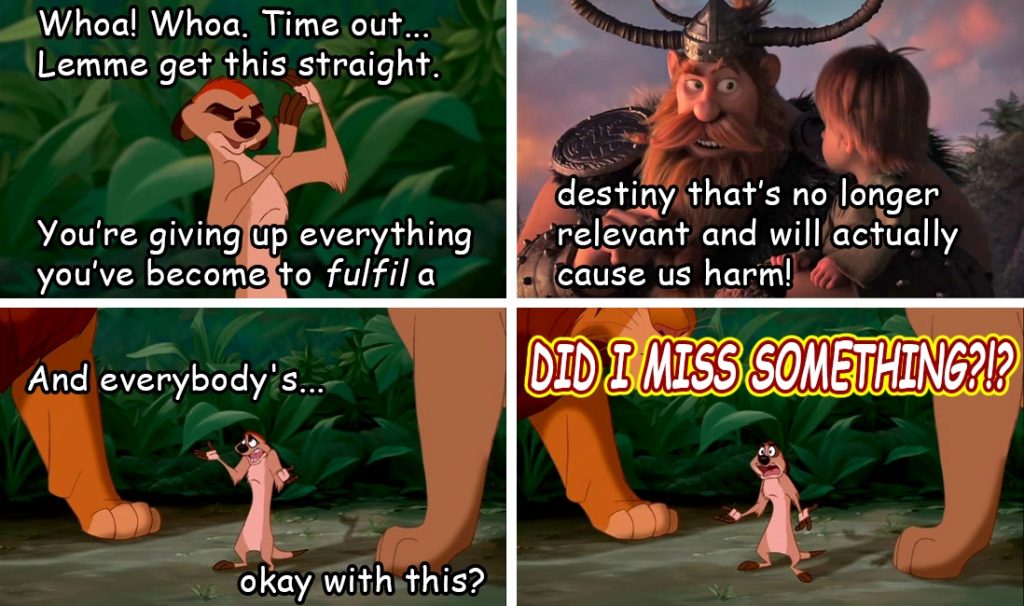

In this movie’s trailer, we see young Hiccup’s father Stoick in a flashback, who has apparently been trying to find and seal off the Hidden World. Stoick tells his son that it’s his destiny to find the Hidden World, and end the war between dragons and the Vikings.
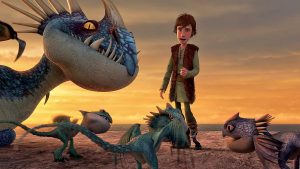

In this story, dragons had already evolved to live and reproduce on the surface for hundreds or thousands of years, making it completely pointless to seal up the entrance to the Hidden World. The dragons even have a favourite island known as “The Rookery” where they hatch their eggs.
Stoick would have had massive “Gronckle”-egg on his face, had he sealed the Hidden World off. The dragons would have remained happily on the surface, and nothing would have changed for the better.
Hiccup had actually already fulfilled “his destiny” in ending the war between dragons and Vikings – at least from the point of view that Stoick had at the time.
Stoick’s tribe was no longer at war with the dragons.
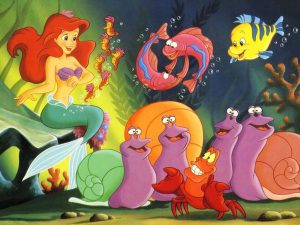

All that remained, was the unreliable Viking fishermans’ myth of a “Hidden World” for the dragons being “out there” somewhere, and the impossibly far-fetched chance of it being found and offering some kind of solution.
Hiccup decided that all Berkians must leave their home, history and achievements of hundreds of years, and live “under the sea” with the dragons, where it’s better “safer”.
(Stop stealing borrowing ideas from Disney, DreamWorks Animation – you have made almost two billion dollars with Shrek alone, by making fun of Disney and some of their fairytales’ more ridiculous moments over the years. Now you’re copying them yourselves – that’s even worse!)
Would you pack up your entire family/tribe, leave behind your home/land/country of generations, and search for the mythical world of Atlantis because you heard a tale of it existing somewhere “out there”? It’s like a page from Disney’s “The Little Mermaid”, only even more far-fetched – Ariel the Mermaid, actually knew the human world existed.
Similar real events have made news headlines around the world, because of how ludicrous they were!
Only recently in 2012, were there religious followers who were absolutely certain the world would end on a certain date: they sold and gave up every single possession in order to come together and prepare for the end of the material world and their earthly bodies.
They must have been pretty embarrassed when it didn’t happen. They sure had (Gronckle) egg on their faces!
Would the “actual” Hiccup and the Berkians from the previous movies truly have decided to go down such an implausible rabbit-hole? Not even “unenlightened” Stoick would have actually given up on his homeland – he only wanted to seal the dragon’s Hidden World off, to protect his own and the Berkian’s homeland!
Forever sending away all the dragons at this point in the story, after all of the progress that had been made, would have only caused harm to everyone. It would have caused harm to the Berkians, who still had a target on their back by their enemies, and it would have caused harm to the dragons, many or most of whom had already adapted to living on the surface. Which brings us to the message of “growing up”, “becoming an adult” and “being independent” which this movie is forcing at any expense:
Apparently “growing up” means bowing to outside pressure of those more savage than you (hunters/warlords), giving up your very strength and identity (your own homeland, making new friends and protecting each other’s lives) and accepting the loss of your idealistic values (that vigilance would create a greater good, and many other values also) to the point of the savage outsiders no longer seeing you as a threat or target worthy of attack.
If you give up everything that is good and dear which may “rock the boat” of the world around you and then keep your head down, then savages truly won’t see you as a threat anymore, because you’ve lost everything they don’t have. Now on a more even level to you and with more ruthlessness, they have the upper hand, and won’t let you regain it either.
You are left with almost nothing. You are the outcast and the outsider, expelled from your own homeland of generations by savages.
Is this what coming of age truly means? The Berkians and dragons had moved on, and moved forward, benefiting them both and ending their conflict – does “growing up” mean giving all progress up, and ending up worse than before?
Of course not, but one wouldn’t know by watching this movie. (By the way: just who or what is the savage in this movie? Whoever this savage is, must be quite badly hated by some portions of the audience by now.)
The result of losing one’s true unwavering idol, and rock?
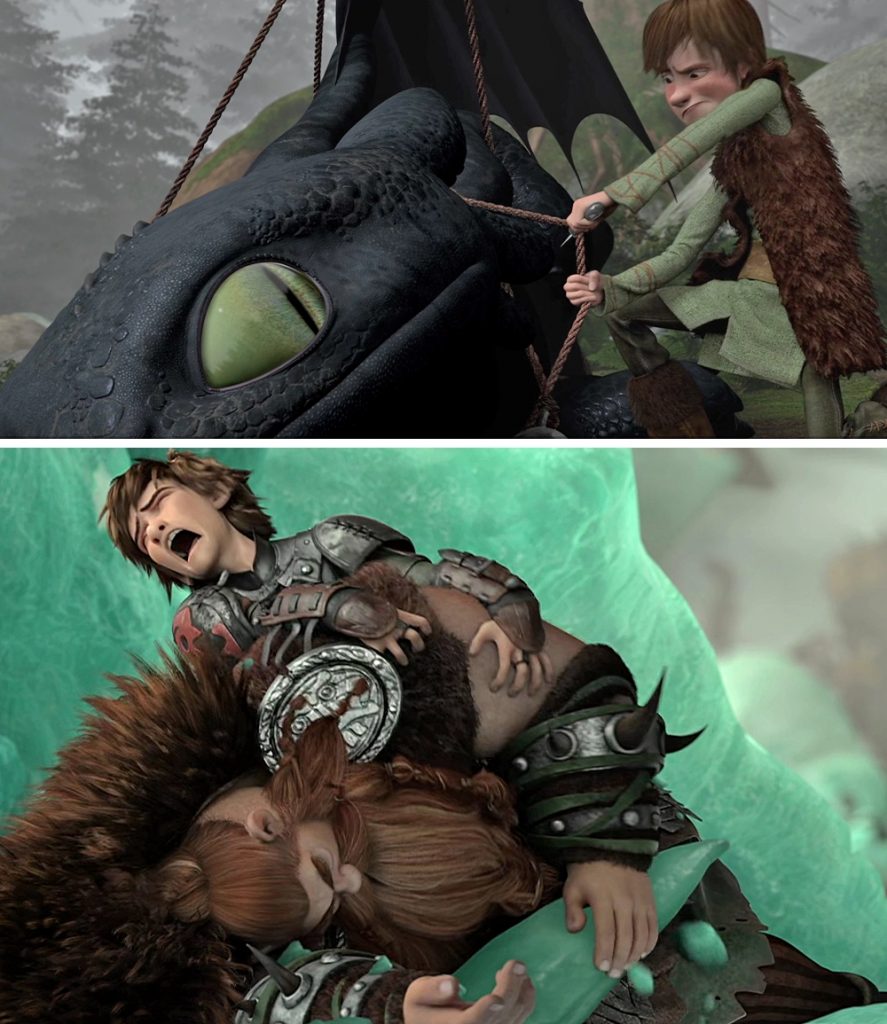

Had Hiccup (and everyone else) become afraid and weaker at his core, due to the violent death of his father? Stoick truly was an intelligent (in his more “limited/old-fashioned” role), sensible and powerful leader with massive boots to fill. In the second movie, Hiccup never really was given time to grieve, but instead seemingly took on the role of leader and left his feelings in the shadows without processing them.
It’s very human to try and make up for pain and weaknesses in one’s life that hadn’t been resolved, by overcompensating in other areas. Hiccup already latched on to the first thing that made him special and stand out, in the very first movie. You couldn’t blame him for befriending Toothless – especially given his lonely and fragile situation. A significant percentage of people in his place may very well have done the same, or at least hoped they could.
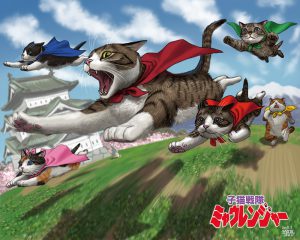

We do on occasion hear of people rescuing and “hoarding” animals to look after them (and sometimes perhaps try to escape the difficult/unchangeable realities of life), only to wear out their own resources and fail in the end. In fact, rules/laws are being debated in Australia, which would make animal hoarding illegal.
Is this what Hiccup and Berk’s mission had been reduced to in this story? A failed attempt to rescue and hoard (exotic) pets, with “Animal Control” closing in? Were the Berkians now reduced to being “Crazy” Cat Dragon People?
In real life, this many exotic (and dangerous) pets would either be caged or need to be put down, as there’s no such thing as a “Hidden World” where they can go to.
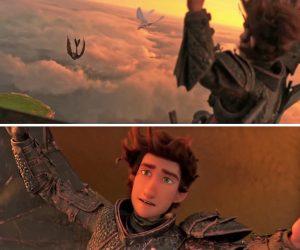

In the movie’s trailer, we see yet another important part of this movie spoiled:
We see Hiccup letting go of the Light Fury, and in doing so accept falling to his death, so that she can save Toothless, who himself is falling after being shot by Grimmel (the Wrathful Crumb).
Making this kind of decision is extremely confronting and can be utterly life changing – especially after years and years of battling against cruel and single-minded outside forces. But not to forget – it can also make many new friends and allies, which the Berkians had done (but shunned and ignored in this movie)!
Seeing his best friend fall to his death, and choosing his friend’s life over his own would indeed cause one to sit back and reevaluate the current situation, or maybe to stop caring/fighting and simply give up.
As mentioned earlier: apparently Stoick was simply reduced to an occasional and misinterpreted voice of the past, rather than someone who still left a lasting impression within the tribe. He appeared to have been dismissed emotionally, with only cherry-picked portions of his now outdated advice brought in, to become the tribe’s only legacy. It’s like he, as a person, was forgotten in the hustle-and-bustle of modern life-and-feelings, and replaced with something that suited a yearning for the easy way out (with its ensuing defeat).
Was this a result of poorly dealing with the death of a tribe’s – indeed a family’s – most powerful and unwavering protector and leader?
Civilisations, nations, tribes and people rise and fall with the strengthening and weakening of the family unit. When tribe-leader Stoick was killed, this final chapter of the HTTYD story could have made the family/tribe stronger and more united than ever before! Instead, it had begun to disintegrate to the point of everyone giving in to fleeting fancies, and giving up their own homeland – along with its accomplishments and history – of many generations.
It’s difficult to not get the sense that when you give up your homeland, you are left with feelings and memories only.
These things die with you, and leave your children with almost nothing.
Not only was the Berkians’ homeland abandoned, but also Stoick’s face carved in the homeland’s mountain – a powerful symbol – and therefore, symbolically also abandoned the things that Stoick represented, and stood for.
Ultimately, the Berkians abandoned their very foundation and ancestry.
Had Stoick’s voice from beyond the grave been made stronger in this story, it would have fiercely kicked and beaten every single alien and Brain Slug into submission. However, Stoick had to be weakened as a voice, as a person, as a father and patriarch, and as a legacy – for the alien subplot and the Brain Slugs to have their free and destructive reign over this story.
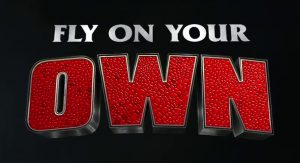

We won’t find out by watching the final movie if Stoick’s death, “coming of age”, or the result of wanting to neatly finish a story at all costs by skewering an overbearing alien subplot, is the reason for the change of Hiccup’s (and the Berkian and dragons’) personality.
We are officially told in the movie trailers and interviews with the movie’s creators, that it’s “coming of age”, so that’s what we’re supposed to believe.
(Source 1, Source 2.)
You’re going to watch it anyway
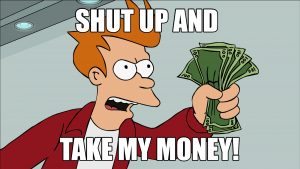

Overall, HTTYD: The Hidden World will likely become another commercial success, despite it being a movie so alien to the actual story of the previous 9 years, since the first hit movie was released.
The carefully-and-psychologically-tuned marketing/orchestration along with peoples’ fondness for the previous stories, is probably too strong for many to simply ignore this final chapter of the story.
Just don’t expect the reasoning process which forever undoes the closest animal and also human friendships the Vikings of Berk had indeed evolved and grown to make, to come from a place of their usual accomplishment.
If Hiccup, the Dragon Riders and the dragons were unrealistically successful before, and had to fall (or get knocked) from grace, then their fall dropped them deeply into a chasm of unrealistic failure.
When looking at this movie’s story from a distance, it becomes clearer just how much plot/screen time is wasted, to try and cover up and explain away all of the characters’ unusual personality changes that were required, to drop them all into their chasm of unrealistic failure.
In real life, there’s usually a balance somewhere in between extremes. We’re all human, we all make mistakes and fail sometimes, and sometimes the world knocks people on their ass, no matter what. However, people also learn from their mistakes – sometimes sooner, sometimes later, but they learn.
The Berkians had come too far and achieved too much in their story, to “realistically” make so many daft decisions.
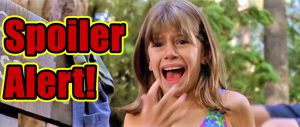

Hiccup’s parting words to Toothless and then the ending narration – possibly there to calm the emotions of those sad to see Vikings and dragons part, and instil a sense of hope for the future – actually make a mockery of the friendships and milestones the viewers have seen develop over the years. You’ll know it when you hear them – apparently teaching the acceptance of tissue-thin platitudes over substance.
It would be disheartening to see children accept such platitudes, rather than rejecting them.
(To see a video I put together, spoiling part of Hiccup’s ending narration and what happens after “The Hidden World’s” ending when the dragons say “Hi”, click here and you will go to a page that will play the 10 minute video. I tried to make Hiccup’s voice sound as close to the original as possible. The default video is lower (mobile) resolution, but you can select the higher resolution video on the page if you want.)
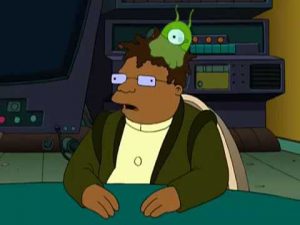

The ending of the original book series was handled with far more emotional intelligence; the Brain Slugs of this movie’s story made an unsuccessful attempt at emulating the original books’ intelligence, possibly due to trying to mix in their own and incompatible demands.
All this apparent interference by the Brain Slugs, seemed to create a mostly disjointed series of events, orchestrated to carry out the Brain Slugs’ wishes while still (unsuccessfully) trying to appear as though everything were normal as before.
Two roads leading to the one solution?








Even if ultimately the only solution was for the dragons to now go underground, there are two different places from which this decision could have been made:
The first place, is the one that grew from the in part newly discovered and adopted foundation of values, strength, identity and vigilance cemented in the first movie – despite the challenges. (Simba from The Lion King came from there, and even the Hiccup from the original book series and previous movies and TV series came from there.)
The second place, is that of those who’ve given up on dealing with the resulting challenges. The final HTTYD movie seems to have come from that second place.


Officially this movie is about “letting go” and how that’s the right thing to do, but with more scrutiny it could easily be seen as a warning to “stand by the consequences of your ideals, keep growing and fight one’s own demise, or else”, because there’s also no real backup plan for the consequences of letting go.
You can however, create backup plans for the consequences of your idealism: especially if you’re resourceful, like the Hiccup(s) of before.
Letting go of one’s values, strengths, identity and even very own homeland, sounds like a recipe for the death of an entire civilisation. That’s a disturbing thing to teach and present as a good thing – especially in a movie for children.
The (ab)use of nature and animals
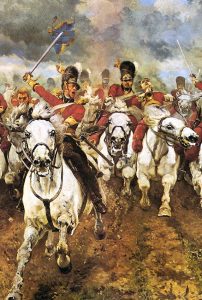

The dragons are still animals, and not people, right? So, therefore it seems the final chapter of the movie trilogy now further amplifies its moral message about not using nature and animals for selfish gain. This particular attempt to make a case for not abusing animals however appears to be yet another effort of “aliens” taking over; the animals must go right now, because the Grimmel-like world is still too primitive and unfair and we’ve run out of energy and ideas.
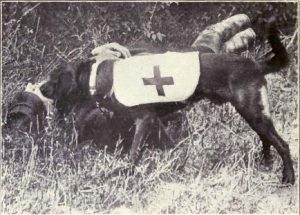

The human race would merely be a primitive shadow of itself, had it never used animals for its personal gain throughout history. To this day, humans keep and use animals as food, clothing, accessories, companions, helpers, teachers, healers, protectors and even enforcers. Humans still use animals to do heavy work (especially in developing countries), we still have guard dogs, we still have mounted police and only recently stopped using horses to fight bloody wars on battlefields – something that’s been done by different cultures for thousands of years.
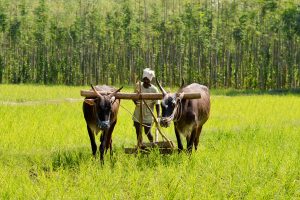

What often gets forgotten, is that even though we’ve used animals throughout history and become a more advanced and plentiful species as a result, the animals that we’ve used and even abused have survived or even flourished as well. We’ve made sure that the animals we’ve relied on, have become more plentiful, and as a result those animals are able to live on into the future.
It’s a mutualistic symbiotic relationship. We profit off each other.


The human race has proven, especially in more recent times of its history, that we can keep animals not only for an abusive and one-sided purpose, but also keep animals in a way that allows them to live reasonably happy, secure and even pampered lives. As long as the animals have their own secure space to be in, their basic needs met, and we learn how they need to be treated and trained to not be dangerous, then humans and animals truly can live together, and both can profit quite evenly and fairly.
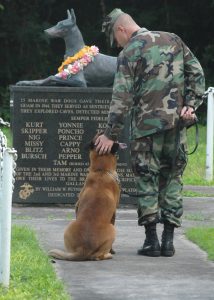

It’s impossible not to see the dragons in this story, without making a connection between them and our own modern-day pets and animals we rely on. This was of course intentional by those who made this story – it made the audience connect at a profound level to the characters they saw.
Looking at this movie’s moral message, are we now to believe that giving up and sending away our pets-friends-allies-helpers, after they have spent thousands of years adapting to closely living with humans, to the point of being able to profoundly understand them and become mutual friends, is good for both humans and animals and the morally correct thing to do?
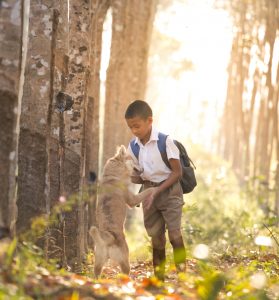

That would be like sending our four-legged friends and other animals (we rely on) into the deserts and forests, then preventing their return and expecting the best. There is no “Hidden World” for them to live in peacefully, and if there would be one, any domesticated animals sent there wouldn’t survive and undomesticated animals would still kill and eat each other.
Unfortunately, there are some people on the planet, who believe that culling all domesticated animals and separating the bond between humans and animals is the right thing to do. However, one must wonder just how aware they are of the actual harm this would do to both.
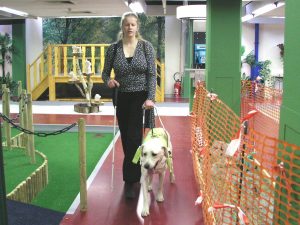

There is no undoing the bond between humans and animals – we can only improve it, look at the problems and ease them, and continue to work on sustainable ways forward that overall won’t cause harm to either humans or animals.
There is no realistic or sustainable part to any message that tries to separate the bond between humans and animals, no matter how much it’s wrapped up in sarcastic veils of morality.
The only sustainable way forward is the essential continued innovation (which must include the intellect, body and soul, as well as education without punishments – for humans and animals), and not abandonment and defeat like we have seen in this movie.
(It’s sometimes not always easy to know what is “innovation” and what is actually the opposite, because the sources of innovation we look towards don’t always get things “right” for a number of big intentional-or-unintentional reasons, but that’s a subject outside the scope of this fansite. Thinking critically, looking at various true historical accounts and choosing different quality sources of information, is always a positive start.)
Let’s also not ignore the fact that every other non-dragon animal shown in the HTTYD movies, hasn’t earned refuge from being slaughtered for food, clothing and accessories. The yak, sheep, chickens and fish may not be as intelligent as most dragons in this story, but the attitudes towards them by the Vikings remained unchanged.
The Hidden World movie in no way offers a solution to the use and abuse of animals and nature that still happens to this day, for another reason:
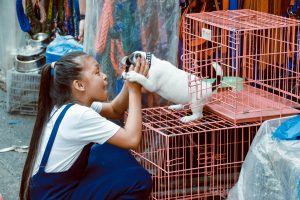

We humans already know there are problems with the way nature and animals are being treated. This movie’s story is a tragedy and loss, because the problems shown were no longer dealt with – instead, the problems were abandoned and hushed up.
A tragedy without solution or at least progress, only leads to hopelessness and perhaps even lashing out, but no actual positive change.
What forms will any level of dispiritedness take on, when emotionally invested viewers (especially the younger ones) who watch this movie, see someone they had every reason to expect would come up with a workable solution or at least compromise, end up failing completely?
Would those viewers develop negative feelings towards whoever/whatever seemed to “take” the dragons away?
Could these emotionally invested viewers develop animosity towards certain people within their own communities, causing further division?
Because this subject appears to have been raised in some reviews, it’ll be mentioned here as well: What if the dragons symbolise (all) people, with their own shared failures, hopes and bravery? Once “outside” people have been accepted into a community, then most will never leave, or be able to be “moved” to a “hidden (safe) world”.
Anything even remotely similar happening for legal immigrants within a community for example, would be impossible to do.
Therefore, would some invested viewers now become polarised against other people within their community, who they perceive as having Grimmel-like features and opinions? Are people intentionally being pitted against each other?
The original book series at least took on this subject in a way that would build the reader up emotionally. The “aliens” however, appear to be using the subject of nature/animal welfare, if only ever so carefully, to help their unusual subplots fly under everyone’s radar.
Is it worth watching?
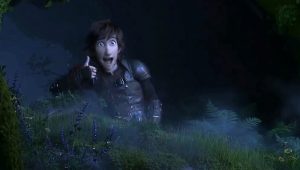

Besides the alien/Brain Slug/time travel story changes, probably the only thing new in “The Hidden World” that wasn’t seen before in the previous movies and TV series, was Toothless falling in love – something that I enjoyed seeing. After all the battles the Dragon Riders and their dragons had been through, they certainly deserved to find such beautiful happiness.
What wasn’t enjoyable however, was how Toothless uncharacteristically seemed to “dump” Hiccup’s friendship after finding a mate, which is something unusual that can’t be explained away by calling him “a wild animal, a dragon”.
Already in the first movie, the dragons had become much more than “just” exotic pets. As the story developed, the Vikings and dragons had become a team, with shared feelings, goals and also shared responsibilities!
Overall, a triumph of modern 3D animation and artistry, a visually beautiful movie but requiring either a deeper, or a shallower analysis of the story to remain palatable:
A deeper analysis to try and understand the “outside motivations” that profoundly altered the characters’ personalities, so that these motivations can be comprehensively discarded where they belong and whatever little remains, enjoyed.
A shallower analysis to simply see a visually impressive movie with big explosions, where everyone gets laid in the end, and then be done with the movie and move on to the next distraction.
This isn’t the best example of a movie to lazily take at face value.
Some professional reviews may have summed up parts of my criticism by saying that “it’s clearly a kids movie”. It’s not that simple, because kids don’t really ignore major errors or “alien” motivations behind a story. Things like obscured adult sexual innuendo may mostly go over their heads, but anything that deals with “growing up” and the state of world around them, is sharply observed and an influence. It’s impossible to stop influences from reaching your kids, but you can be their, and your own, greatest positive influence.


It sure sounds like quite a vicious battle for your mind (and money)!
The fractured family and tribe/society
Are the HTTYD movies, the story of the decay/death of a community/society that didn’t value its own past, present and future over its irresponsible and blind youthful idealism? After all, the Berkians did end up not only completely isolated from other Vikings, allies, friends – they forever lost their homeland, and the dragons they had loved and fought for. They were far worse off than before.
In the previous second movie, Hiccup’s mistakes were very clearly beginning to show when he ignored his father Stoick’s advice and underestimated (the main antagonist/evildoer/dragon enslaver) Drago Bludvist’s blind and savage ruthlessness against that what he feared – the dragons.
The second movie’s story was already starting to move towards an unsustainable situation, by shifting away from the unbreakable and innocent friendship between a dragon and a boy in the first movie – consequences started creeping in. Things were heading towards leadership challenges, “kings and successions”, and fighting battles against destructive forces one may never have met otherwise. (That’s “life”, and also what happened in the original book series.)
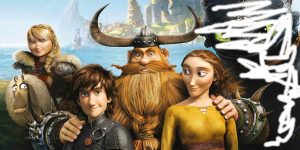

Had Hiccup obeyed his father in the first movie, and stayed indoors as told, then Vikings and dragons would still have been at war, but his father would likely also have lived.
Had Valka (Hiccup’s like-minded mother and Stoick’s wife) been a stronger parent, partner and responsible family/tribe member, then she would have seen her son grow up and contributed to his raising, rather than leaving Stoick alone and heartbroken, to raise their infant son believing her to be dead.
From Valka’s point of view, she believed she was being responsible, considering the harsh circumstances, and therefore doing what she believed was best. Being friendly towards the dragons, her situation was different to that of the other tribe-members – men and women, and that changed her actions, too.
However, Valka’s point of view ultimately cost her – and her family – terribly.
As a consequence, Stoick very much became a victim of the blind idealism of those around him, to the ultimate detriment of everyone. He ended up being forced to sacrifice his life, therefore leaving a scarred and overwhelmed young Hiccup to take his place, with a mother that (whatever the reason) had actually abandoned him.
(Looking at that differently however, by Valka not returning, she possibly did give him more freedom and time to make up his own mind, without her unpopular point of view causing further friction.)
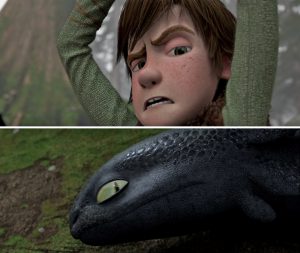

Hiccup further set in motion unchangeable and in fact terrible events, stemming from the youthful idealism and empathy coming from a near-outcast, to an outsider – a dragon – in which he saw (in ways) himself. A very human thing to do, that a lot of the movie’s audience connected with. So, what are we to connect with in this final movie, when only platitudes remain?
We know that we had better be prepared to accept the consequences of our idealism, and then adapt and learn in order to bear them responsibly, or at least curb our idealism until we’re ready to “live” it. But if we fail in bearing these new responsibilities, then the ending won’t be “okay and bittersweet” like in this final movie – it would actually be a destructive, irreversible mess.
The outside world would close in regardless, conflict would be inevitable. The road to hell truly is paved with good intentions, after all.
This final movie and story could have resolved the mistakes that had led to an unsustainable situation, without all Dragon Riders and Berkians giving up on the firm idealistic beliefs of the last six or so years of their story.
It’s too great a loss, to be any kind of happy or “bittersweet” ending, which is what the movie’s makers are calling it.
It seems this movie’s unusual personality changes of its characters, leading to the loss of their ideals, is being artificially consoled. Ultimately the characters lost more than their friendship with dragons; they lost their ideals, because they stopped searching for sustainable ways of maintaining them, and therefore, they failed… with only hollow final words to comfort them.
Had the Vikings of Berk driven the dragons into the “Hidden World” without becoming their friends first, then they would have ultimately succeeded and won the war according to their “less-enlightened” beliefs at the time, with proud tales of victory and an end to war, being told over generations to come.
(Although, one can wonder what the Berkians would have done with all their spare time and “less-enlightened” beliefs then.)
This raises the question – is it possible to actually succeed, when throwing oneself into (youthful) ideals, but still also bear the increasing responsibility to ourselves and family/tribe as the years go on?
Maybe (with enough wisdom) it is possible, but along with this idealism come many new and often unwanted consequences – of not only failure but also success, that one must know about and prepare for.
Showing how not to do things: just as valuable?
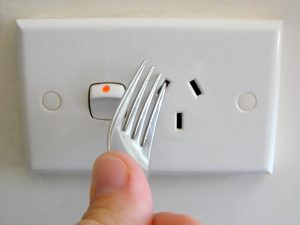

Perhaps this movie (unintentionally?) offers an insightful view into the future of a society that doesn’t either keep its enemies away, or hold on to its closest true friends and allies – or at least work towards the most thought-out solutions possible, no matter what the challenge.
Perhaps the friendship between Vikings and dragons should never have happened, even if the friendship between Vikings and dragons was based on an idealistic and childish innocence. Some of the fairest and most human of qualities that we as a society consider hallmarks of our advancement, are deeply rooted in a childlike worldview and idealism.
However, there’s no such thing as a “Hidden World” as a backup plan for the consequences of one’s practiced childlike ideals.
In the spirit (and constraints) of this story, consider that there are no more “Berkians” either – it’s not just the dragons who have disappeared (down a giant plughole).
Hiccup’s decision to quit searching for new solutions like he and his friends always had before, and instead hastily give up his (tribe’s) homeland and send the dragons away – possibly made out of desperation and fatigue – may have therefore doomed his tribe into irrelevance and distant buried history.
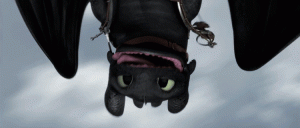

The brilliant technical advances that came about in this story, only really happened because of the dragons’ presence – first to defend against, and then to protect them.
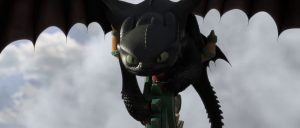

Unfortunately, the dragons were forced to live underground, never again to see the sky and endless expanse they clearly enjoyed and thrived in, with Toothless and the future alphas now reduced to being their prison wardens. Living around humans, also advanced the dragons in many ways. Now the dragons will forever forget the humans’ positive contributions, and all of their and the Vikings’ achievements will have been in vain.
However, the world was going to close in on the dragons sooner or later, no matter if the Berkians had befriended the dragons or not.
At the very crossroads of the story, Hiccup had the power, experience and chance to come up with a plan or compromise, that would still have allowed the dragons to remain safely on the surface, and allow their freedom! (See “How could a true sequel have ended” above.)
This freedom would likely have been more cautious and restricted, but freedom away from hostile humans nonetheless, and free choice to visit and be with the Berkians and all the other human friends they had made over time.
Yet in this movie, with this alien version of Hiccup, he chose what could (if one would be perhaps a little cynical) easily be described as “If I can’t have you, then no one can”. He chose this not only for himself, but for his entire tribe, who all had come to love the dragons.
He knew how to come up with amazing plans – his whole Dragon Rider team did – yet he chose to hoard the dragons in an artificial habitat (Berk) against all better judgment and knowledge, which he couldn’t maintain anymore.
Ignorance was no excuse – especially since he had already proven himself many times over.
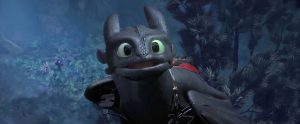

Perhaps Toothless wouldn’t have so easily considered leaving Hiccup, and staying in the Hidden World, if Hiccup had been a stronger leader – better able to protect not only his tribe, but also the dragons.
In a way, Toothless did in this movie, what Hiccup had done in the first movie – looking after his own interests:
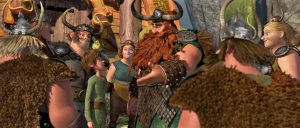


Hiccup started warming to the idea of no longer being the rejected outcast he had been his whole life, by making the most of what he was good at – befriending and protecting the dragons.


Toothless started warming to the idea of a lifetime of being king and making having offspring, by separating from a friend he loved but was probably going to get him killed, due to his friend repeating the same mistakes and apparently being unable to learn from them.
Hiccup and Toothless looking after their own interests isn’t “bad” – but it can quickly have serious lifelong consequences, if not planned out and balanced.
Giving and receiving in equal measure; if there’s an imbalance, then friendships can go wrong no matter how idealistic their beginnings have been. If friendships on a leader/king level are going wrong, certainly that will amplify the resulting damage.
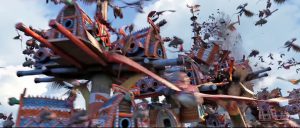

This movie’s alien version of Hiccup, failed his tribe and failed the dragons – perhaps it wasn’t the outside world closing in, which was the actual problem in the story. Perhaps the problem was Hiccup’s internal inability to continue living up to his (and his ancestors’) significant achievements, causing the world he had control over, to collapse and take those around him with it.
The closing “we’ll guard this secret (Hidden World)” narration of this movie is ridiculous for all kinds of reasons, one of them being that someone who had failed and collapsed as badly as the Berkians had, would not be able to pass on any kind of lasting legacy. Another reason (of many) is that in this story, the dragons appear to have a very short memory of only a few years – if/when they do emerge, they might just see billions of walking and benevolent “Meat Popsicles” to gnaw on, rather than befriend.
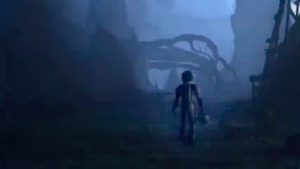

Perhaps after all, Hiccup was simply overestimated, and totally overstretched. Not everyone can be an influential hero, against the “weight of the world”.
Perhaps, even with his friendships and achievements, he was simply unable to go on – not having anything more to give.
Still, it was quite clear that if a more thought-out and better implemented plan (reminiscent of the earlier Hiccup from the previous movies) had been put in place, then this total collapse and resulting division could have been delayed by many years or perhaps even prevented. At the very least, it could have bought more time.
Why could Hiccup apparently no longer go on doing, what he had always done for the dragons before?
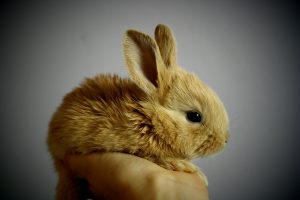

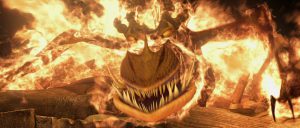

These dragons are not, and never were defenseless! The dragons always had a huge advantage in weaponry, defense, stealth and mobility over the humans. Dragons were never helpless kittens or bunnies who were simply “misunderstood” – they also attacked and killed people. The dragons had evolved fierce strength and weaponry – and the attitude that comes with it – to better defend against and kill each other, but also in effect, anything else that tried to attack or “displease” them!
Doesn’t sound like a meek package!
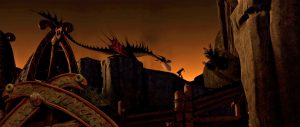

In other words: There is no logic behind assuming that any creature with such fierce offense and defense capability, would shrink like a violet when confronted by much smaller humans with breakable/burnable spears and arrows – especially when the dragons are wild and in groups, and when it is so easy for them to escape.
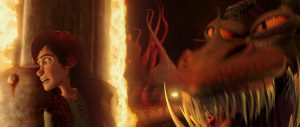

The dragons not only had their own spears and arrows growing on their bodies, they also had massive firepower, size and a tough exterior. No dragon would ever get a paper cut, when restocking the home printer or sealing an envelope to post.
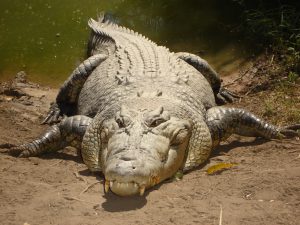

For a reality check, try overpowering a fully-grown saltwater crocodile or a deadly Easter Brown or Coastal Taipan snake, or maybe a nice and “defenseless” Komodo Dragon.
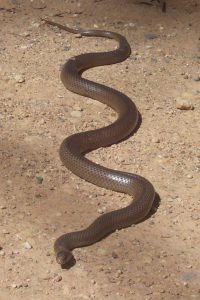

All of these creatures have hunted and killed humans, for thousands of years – sometimes out of self-defense, sometimes for “food supply” and sometimes for other reasons.
Try catching a bird that doesn’t want to get caught – they’re fast!
The dragons in the HTTYD movies were all of those creatures mixed together (and wolves, tigers, panthers, lions, rhinos, etc. as well), and at least five times bigger.
A Maltese Terrier-sized “Terrible Terror” dragon had already overpowered a Viking, in the first movie.
Altogether, maybe that puts things into perspective a little more.
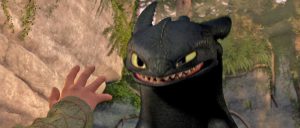

The dragons are fierce and dangerous. It took thousands of years of dragons having an advantage and in ways also ruling over, terrorising and killing humans, before a single boy reached out to a disabled unwilling dragon, and helped him fly again, before common ground was found and built upon.
(If the dragons themselves had reached out to young boys or girls, then perhaps the dragons would have been the first to find common ground and build bridges between divides, over time.)
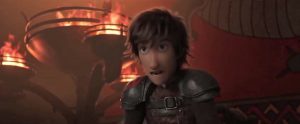

Such moments of shared understanding and friendship are encouraging and beautiful. However the dragons in this final movie, with all their might and even (near) human intelligence, decided against helping the Berkians remain in their own homeland. Berk was clearly very important to all the people there. The dragons had a very good understanding of just how important the Berkians’ homeland was to their human friends – after all, the Berkians had been defending it (from the dragons and other threats) for more than 700 years.


The dragons also failed to suggest a better housing situation, when it started getting unusually crowded and unsustainable in Berk. Why not gratefully return to their own environment, after having been rescued by the Berkians?
Actually, it’s common for rescuers all around the world to rehabilitate injured and trapped wild animals, and then release them back into the wild, where they belong.
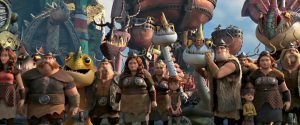

The dragons had also failed to show the Berkians the same level of dedication and friendship, that the Berkians had shown the dragons, when times got tough.
The Berkians have risked and given up everything, at terrible expense to themselves, to try and give the dragons a better life.
During the risky missions to rescue captured dragons: the dragons Toothless, Stormfly, Meatlug, Hookfang and Barf-and-Belch all went along as a team, and as team-members who were highly valued and loved by the Dragon Riders.
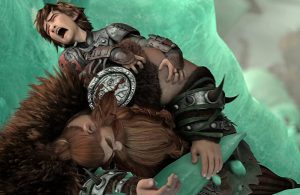

Once the Dragon Riders and Berkians had overstretched themselves and started dying and suffering in their efforts to help the dragons, and Toothless had found a queen to spend his life with, away from his human friends, then things changed very quickly:
Toothless didn’t redouble his efforts to help his human friends get back on their feet – instead, he left them alone and hated by their shared dragon-hunter enemies that the Berkians would never have made, had they not helped the dragons in the first place! That is extremely ungrateful and selfish behaviour.


Ultimately, Toothless left the Berkians homeless, isolated, defeated, mostly-defenseless, hunted and heartbroken!
Would the Toothless from the previous movies, shorts and TV series truly have acted like this, or would he have stood by his best friend’s side, and stepped up to the challenge when he saw his best friend falter? Toothless would have stood by his best (and very capable) friend, and helped him get back on his feet.
Those points were grossly and increasingly underplayed by this movie’s story. A lot of effort was put into the story of this final HTTYD movie, to pretend that the dragons had fewer capabilities and therefore also fewer responsibilities, than they actually had!
(Why this discrepancy between the first two movies/TV series, and this third and last movie?)
Unequal giving and receiving.
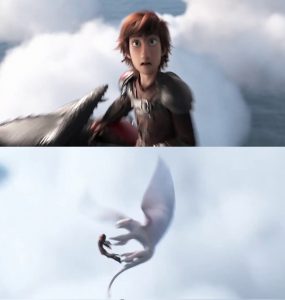

Nature is unfair, and so are people – this is a fact that cannot be changed, as it’s written in the DNA.
When the humans started to fail in looking after the dragons, in the ways that suited the dragons, then the dragons simply flew off and left the humans to deal with the terrible consequences of their blind idealistic support and dedication towards them.
Certainly, idealism, values, wisdom, respect and innovation are some of the things that can help overcome the unfairness and selfishness in nature and humans, but in the end, these things were demonstrated less by the dragons, than by the humans.
(These things happen, and everyone has different abilities. It’s important to be aware of this, and without lying to oneself, make the most of one’s own abilities, for the greater good.)
Perhaps the humans would have been better off after all, by rejecting the dragons and keeping them under control. Perhaps the dragons – not being able (or willing?) to give as much as they receive – should live in a land where they can go back to hunting and killing each other, without interfering with the increasingly more complex and also somehow more idealistic lives (at least in theory), of the humans.
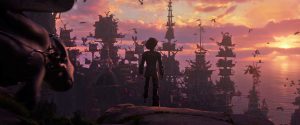

The dragons left within a few short years, of the humans’ weapons slowly starting to match their own weapons.
What kind of human world would actually suit the dragons?! A world where only the dragons have the incredible weaponry, and humans are once again defenseless mostly-unarmed sheepish pushovers, who would give up their own comforts, homes, lifestyles and safety – to serve, house and feed the hungry dragons?
Is this the kind of people that humans need to become, before the dragons come out again to give the humans cuddles and face licks? If true friendship goes both ways (which it does), then maybe the dragons were never actually friends to the humans, perhaps simply due to being incompatible with the natural and positive progress of mankind. Maybe the dragons are better off staying where they are, after all.
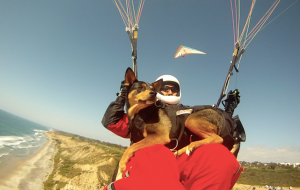

Wolves reached out to humans (for the food at first, of course) and then went on to become our best friends: as the dogs we love, and who love us!
By the way, if you want to fly with reasonable safety, then it’s not even that difficult anymore.
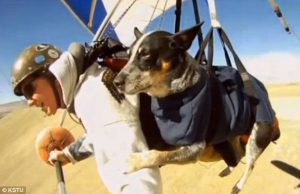


It’s possible to learn to safely fly powered ultra-light planes, and un-powered gliders.
With good training, you can even take your dog along, if you want! (Although a good portion of them would still prefer staying on the ground.)
One doesn’t actually “need” a dragon (anymore), to fly with our best friends. (See more info/sources at bottom of page.)
It seems that Hiccup failed, because the dragons he so loved, hadn’t given back to him what they had received when times got tough and consequences became pressing. (Giving should not be done in the hope or expectation to receive – it must be done with a selfless attitude and manner.) However it seems that in this movie, Hiccup had no more to give, and didn’t receive enough to keep on giving.
Glaringly, this final HTTYD movie doesn’t explore the above mentioned to any profound extent – instead it celebrates Hiccup’s and the dragons’ far-reaching failures, and very clearly places any blame on the world outside of theirs. Or more specifically – the blame is placed upon a certain portion of the world outside of theirs…
Perhaps it’s not the work of Brain Slugs, aliens or time travel gone wrong!
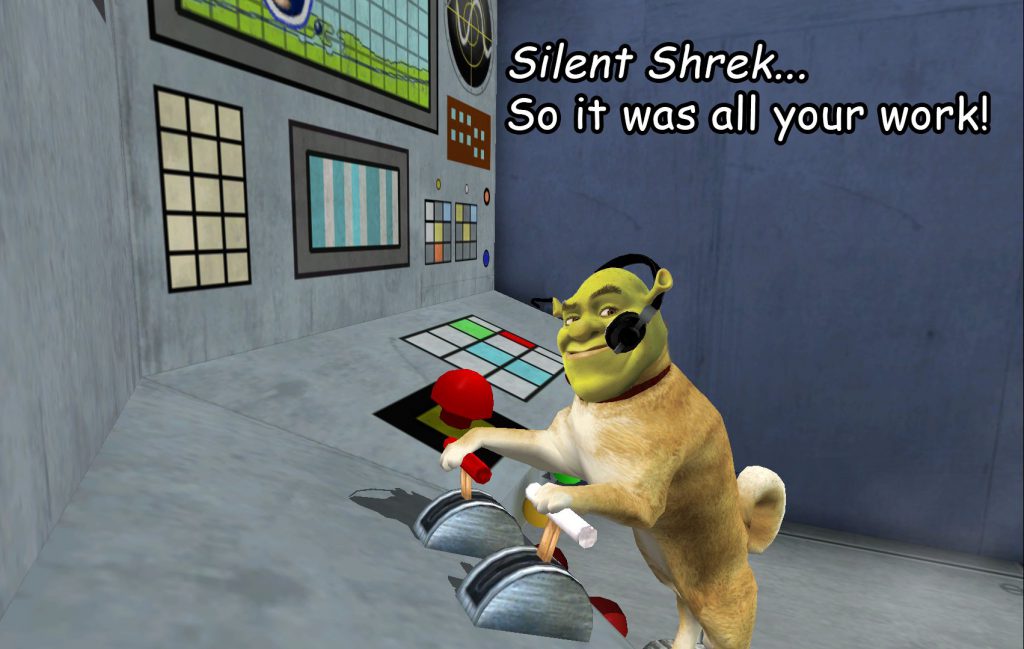

DreamWorks Animation have made a real impact with movies like Shrek, by “taking the Mickey” out of fairytales with harsh and smelly jaded-reality-based critiques.


So with this movie apparently in some weird way doing the same thing – saying that idealistic and inspirational heroes, will ultimately fail from a place of overwhelm, despite promising beginnings and their strong results – then why is this final movie loudly hailed as the opposite by its makers? (Source 1, source 2, etc.)
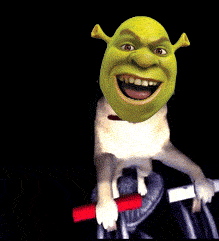

The “How to Train Your Dragon: The Hidden World” movie is not a tale of successfully avoiding conflict and finding one’s inner strength to lead without help, as the alien subplot wants us to believe: it’s a tale of finding one’s inner strength to lead a small, anonymous, mentally/physically/spiritually-draining and compromised life, revel in platitudes, and hope for the best for oneself and family.
Unfortunately, even that is something a lot of people can nowadays only aspire to, so in a way, it’s yet again quite a “realistic” fairytale – farts, earwax and everything else included.
There is no “alien subplot” or Brain Slug infestation or even time travel gone wrong, after all – it was Shrek all along!
He’s been pushing the buttons and pulling the levers of this increasingly disturbing story from the very beginning.
Had this been a classic Disney movie, then Hiccup would have managed to create the most perfect ending possible, despite the circumstances, and true to his glowing inner strength and nature – but in a still remotely plausible way.
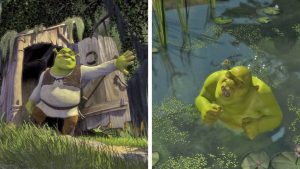

I never really connected with DreamWorks Animation fairytales and certainly not Shrek, because they didn’t seem to offer an attainable but still lofty goal to reach.
The fairytales made it not only okay, but even in ways “good and smart” to fail and give up lofty goals. DreamWorks Animation were sneaky this time around – “slipping me a Shrek”, without me realising it at first.
Here I was: thinking I’d get a Disney-like ending after faithfully following the movies and TV series, and all I got in the very end was a smelly green mooning.
Bait-and-switch! These guys are diabolically meticulous with their stories, and execution. Copying from classic-Disney, then pulling the story’s pants down and letting it hit the fan(s).
Even their own fairytales’ gaping plot holes can be explained by Shrek wiping himself and farting in a pond. If DreamWorks Animation’s fractured fairytale trend continues, then I’ll already know all the endings to their future fairytales: failure, no matter how promising the beginnings, and how that’s actually good and normal.
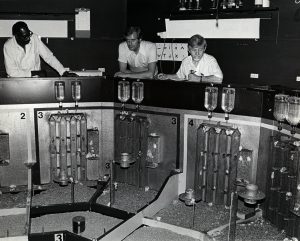

The genuine reviews and candid social media comments from this movie’s relatively limited release before being shown in the USA, will likely help fine-tune its marketing there.
It makes sense to give this particular story as it is, a limited release and learn from and respond to the reactions before it gets seen by its main audience.
DreamWorks Animation certainly succeeded in crafting a fairytale that is different from what one would expect (or hope), when thinking of the word “fairytale”.
There’s a cynical part of me that I’d rather not have dealt with while watching this fairytale: detecting increasing parallels between certain sides of the current pro-and-anti guns debate for example, and seeing current debates influence a simple mostly-timeless fairytale I was fond of, the way popular news and media like to influence peoples’ minds and reality.
Bias and opinions have been a part of “news and media” since its beginning, but it seems that bias and opinions are increasingly and more comprehensively being pushed as real and factual. Emotion often sells better than actual facts, statistics, and the quiet and sensible middle-ground – emotion also influences.
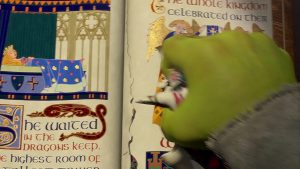

I like to think that in this HTTYD fairytale, everyone throwing their only real means of protecting themselves and each other (their mighty dragons) into the bottom of the sea (Hidden World), now that the outside world is closing in, and being told that doing this will have no real consequences other than bitter-sweet feelings, is just an example of Shrek wiping himself with pages of the HTTYD fairytale book after filling his smelly hole in the ground.
The HTTYD story was too enjoyable to me overall, to want it skewed by anything more intentional. I don’t really want to discover all of the references to the modern and increasingly exhausting political battles that we’re all enduring.
After all, people watch these kinds of stories to get away from the real world for a short time, don’t they?
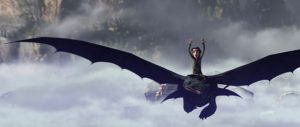

Unfortunately, it seems that partly the second but especially this third and final HTTYD movie appeared to be riding on the success of the first one.
The first movie managed to cleverly blend an obvious politicised message of tolerance towards outsiders, with enough tact, intelligence and distance for it to make a positive story that almost everyone could, and did agree with.
If one didn’t like today’s “politicisation-of-everything” and wanted to escape its reach if only for a moment, then they could still agree that letting the dragon Toothless free instead of killing him, was the right thing to do.


Unfortunately, it seems that drunk with its own success, the story later started mixing in all kinds of other themes being heatedly slung in our political climate of this century. That means the main person Hiccup, together with his dragon-friend Toothless and the Berkians with their dragon-friends all now had to carry the weight of our current political mess as well.
A number of viewers’ reviews started pointing to confusion at the story in the second movie, and that seems to be increasing with this final, third movie.
This final movie, probably comes too close to the real-life themes being heaped upon everyday people, who are simply trying to get on with work and family matters. Hiccup and the now “poor and defenseless pet-dragons” were becoming the benevolent-modern-day effigy – torn down by the savage genocidal relic of the past.
The previous presentation of Hiccup, was a representation of the positive idealistic dreamer, but also a learner and a doer, who is inside so many children and also (to varying degrees), still inside grown-ups.
The earlier Hiccup was timeless and universal – he was a part of very many people.
The many enemies of the positive idealistic dreamers, learners and doers, are far more diverse, vague, universal, hidden and also shared, than the enemies shown in this final third HTTYD movie. The same enemies that exist outside, also (to varying degrees) exist on the inside.
There aren’t too many people who want to be reminded of their own faults – sometimes it’s just easier to blame and hate an effigy of someone else, and be done with it.
(But it’s also more destructive and divisive.)
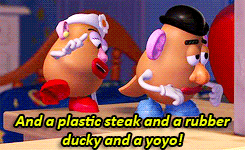

This movie feels like it has become overzealous in what it’s trying to do, and things had started to no longer make sense as a result.
The movie started packing in every possible thing but the kitchen sink into the story, and squeezing it into 104 minutes, whether it makes sense or not. Changing the characters’ very personalities should not have been an option, to finish off this story.
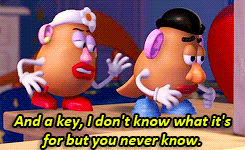

Had the theme remained simpler, like in the first movie and much of the TV series, then it would have worked its purpose naturally.
The “simpler” lessons of being true to oneself, being in touch with nature, being compassionate, being brave and keeping an open mind (without ignoring true history’s lessons and constructive, positive values) are already big enough!
Rather, the story neared an overbearing at-all-cost part-and-reminder of the forced-upon division young people and adults once again must face, when they leave the cinemas.
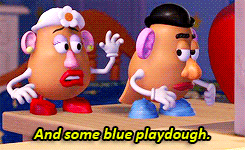

Life does move on and get more complicated (especially for each generation of young people), but the transitions from one stage of life to the next can remain natural.
However, life’s transitions can also have an unnatural outside influence, which this movie’s characters seem to have. This unnatural outside influence, appears to ignore the more intelligent and positive values and message built up with the first two movies, TV series (and original books).
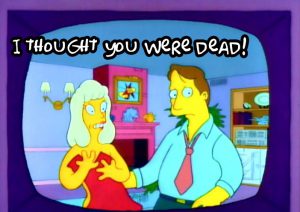

It’s exhausting to constantly be reminded of the world’s terrible and seemingly inescapable problems, and then (get tricked into) witnessing many of those unresolved problems directly
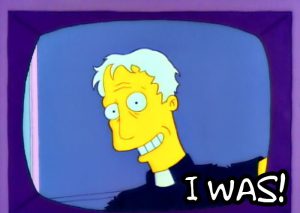

influence a simple and positive story, that was close to a lot of peoples’ hearts (mine included).
At what point can willing suspension of disbelief no longer be maintained?


If you need evidence of these sentiments being shared by many other people, then look at the most popular fanart of this movie franchise throughout the years: no doubt you will overwhelmingly see the Dragon Riders and their dragons being unbreakable friends through the pains and joys of life, and still managing to rest and find the beauty and innocence that still remains in our world.
Is that not a beautiful theme? It is something that almost all humans want, and in their own ways hunger for, but also work towards achieving those positive things for themselves, their families and their own greater communities. Art: Link 1 | Link 2 | Link 3 | Link 4 | Link 5 | Link 6 | Link 7 | Link 8 | Link 9 | Link 10 | Link 11 | Link 12 | Link 13 | Link 14 | Link 15 | Link 16 | Link 17 | Link 18 etc. (opens new browser window).
Where is the chance for momentary rest and relief, when even the simple means of doing this, such as watching a fairytale, begin to mirror the very thing that one is trying to find temporary relief from? Looking at a fairytale, and seeing the problems of everyday life played out all over again, without any real solution.
Don’t people watch fairytales to get some relief from the problems of everyday life… or perhaps even find some hope?
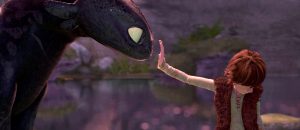

A fairytale can certainly go ahead and make a moral message. However, there’s a line that gets crossed when that fairytale becomes too much like a single side of the vicious battles one sees when turning on the news, rather than staying true to its simple foundations: telling of the shared timeless battles within each and every human being, and the possible solutions and hopes for the future.
Politics always divide, and no one side is ever 100% correct. This movie’s final blow, in order to force its own side of the message, came to a brutal point: during the final battle with Grimmel (the Bogeyman) – and all that he represented – with the immediately resulting final tragic and hopeless scenes.
It seems the changes in character of the Vikings and the dragons were deemed necessary, to reduce the movie’s final moments into a tool of partisan influence, rather than a positive and uniting example. Unfortunately, this was done by using the primitive tactic of giving something beautiful (such as the positive peace and unity in the first movie), taking it away without chance for objecting or making it better somehow (the Berkians spent an entire hour of this movie desperately running like startled insects, or saying goodbye) and then blaming someone else – and all that he/they represent – for it.
Doing such a thing will cause at least some division, bitterness and resentment. Is there not a potential of poisoning young, impressionable minds and their natural mechanisms of dealing with problems?
Couldn’t this have the potential for fuelling depression and hopelessness in impressionable youth, coming to terms with the adult world’s overwhelming problems?
Such a primitive and overused tactic: for maximum effect, stirring up whatever the opposites of intelligence, respect and understanding are – by sacrificing the positive message (of the first movie).
It was disappointing to witness this final chapter of a story I enjoyed a lot, being reduced and misused like this.
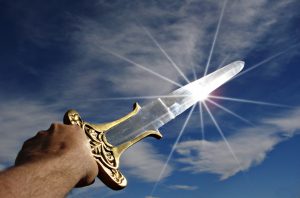

The story of the original book series by Cressida Cowell also involved the reader and even directly addressed them, in a call to action (within the confines of metaphors), to carry on the positive mission of Hiccup.
The way this was done however, was by calling upon personal but positive emotions – not by calling upon division, bitterness and resentment like the final HTTYD movie did, with:
- dismantling of the very things that made the story positive, hopeful and personal to many viewers (such as that friendships can be built on common ground, positive effort and idealism can and does pay off and leave a positive legacy, even when ultimately one’s goal is never reached, that constant learning and self-improvement will result in greater strength)
- the direction of blame towards a more singular bogeyman rather than a more general (shared) and metaphorical enemy
- its brutal, debased final battle and resulting ending
- and perhaps most importantly – the movie having no suggestion of a framework/possibilities of resolving the negative results, in a positive and non-destructive way.
This movie “tears down”, but offers no constructive and positive way of “building up” again.
The book series’ call to action was for eternally striving towards personal betterment and using brains rather than brawn – to reject a generally vague form of intolerance, that every side of the political spectrum, belief and human character has shown towards the other, and instead work towards finding common ground. One can hope (or expect), that all sides and beliefs listen to this “call” equally then, rather than just the (more benevolent) one.
But what is the final HTTYD movie actually trying to achieve?
History, nature and any complex society in the animal kingdom has demonstrated, that it’s important to understand the similarities shared by all humans, as well as by animals. It’s equally important to respect our differences and especially our own patches of land and life that we have carved out for ourselves, our like-minded communities and our (future) families.
After all, this need for peace, community, but also ownership is written into the very DNA of advanced (human and animal) societies.
Any over-simplified message of “either this or nothing” is far too crass and dividing: working against any positive efforts towards unity and (shared) understanding.
A percentage of the movie’s audience will likely want what was “taken” from them even more, and blames the well-defined and identifiable human bogeyman (rather than shared weaknesses) for taking it from them – subconsciously or consciously. This is a lot to cram into a movie (mostly) for children – especially since children are far more open to taking things they see in movies as real.
The baseness of some elements in this movie belong in the adult world.
How many 21st century divisive battles can be crammed into a simpler “mythical story of Vikings and dragons from long ago”, without the whole story collapsing?
Fewer than were forced into this particular story.



Where has the tact and emotional intelligence from this story’s foundations gone? The story that still allowed for borders and personal space to grow (something that all intelligent creatures require), but also promoted the continuing and idealistic efforts towards respect, friendship and peace between divides.
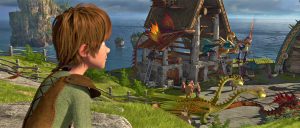

The first two movies, TV series and original book series, clearly strove towards achieving this idealistic goal.
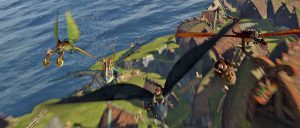

Those are worthy and attainable goals, that only become harder to achieve when fingers get pointed (this bogeyman
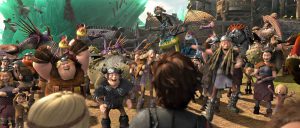

is to blame), room for self-expression is reduced (we must react and run, not defend) and ultimatums are made into the only solutions (we must give up, divide and
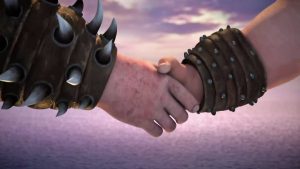

separate no matter what) – that just sounds like a recipe for trouble. Forcing reactions based on negative emotion, rather than rational reasoning or positive emotion. These are destructive things which only divide, rather than unite.
The distortion/abandonment of virtue and values
I’m glad that when I had decided to create this HTTYD fansite, the main focus was to be on collecting my favourite art and other creative works by fans, to show it in the one nice place for everyone to see, and hopefully inspire even more creativity.
The web developer in me saw a niche and wanted to fill it, as a homage to the story that pulled me in, and a homage to the fanart artists and creatives who so beautifully told and retold it.
In obvious contrast to the HTTYD fanart and the overall story up to this point, this movie’s story appears to have deflated into something that reduces the meaning and importance of:
- Family. The tribe and family replacing (tribe leader, husband to Valka) Stoick’s strong leadership, dedication and influence after his death with weaker alternatives such as overwhelm, compromise and less-connected relationships, Valka then reciprocating disrespectful and fleeting romantic advances from a Dragon Rider/Hiccup’s friend. Completely isolating themselves from the rest of (Viking) society, and therefore dooming themselves and their future children into isolation/irrelevance. The tribe and family strength and unity were always of utmost importance in the previous versions of the HTTYD story.
- Friendship. True friends would stick together and support each other no matter what, rather than give in when faced with challenges. For example, defending against outside threats to each other, but also mindfully managing the desire for, and finding of like-minded romantic partners. Friendship and sticking together through hard times, was always highly valued as well.
Giving and receiving, without expectation. - History. Abandoning their homeland, allies, neighbours, friends, experiences, tradition and ancestry that had gotten the Berkian tribe as far as they had – starting from scratch on a whim. Again, the Berkians were very proud of their achievements – and they in fact had achieved a great deal to be proud of.
- Responsibility. Making rash or selfish emotional decisions that only endanger, marginalise and disempower the tribe and its friends – leaving a strong and defensible stronghold for a mythical land is incredibly irresponsible to everyone. That also means leaving an established trading route and food source and completely isolating themselves from nearby human allies/tribes/communities. Separating from human and dragon friends proven to make themselves and also their friends stronger is also irresponsible, and doing all this with hunters/warlords/enemies who want the tribe’s blood no matter what, is crazy-irresponsible. Are they completely suicidal?!
When has this ever happened to any real extent in the HTTYD story – when were the Berkians ever this irresponsible?
- Values. Oh boy, what a biggie this one is! The Berkians had abandoned almost all of their values, and the values of true Vikings. They had abandoned the values that supported this story from its beginnings as a book series starting in 2003, and the first movie in 2010…
So, to continue the subject of values, the following websites explain the Viking Values quite well – they’re worth a look: thewisdomwarrior.com/2010/09/17/the-nine-noble-virtues-viking-values-for-the-warrior-lifestyle and vikingmartialarts.com/vikingculture/2017/6/14/veien-the-way-of-the-viking-warrior-by-tyr-neilsen
I will quote the explanations of the Viking Values, from the “Wisdom Warrior” website, and then go on to argue how the Berkians haven’t lived up to those values in this HTTYD movie, even though they appear to have lived up to them previously.
The interpretations of the Viking Values differ a little bit between people and websites, but those on the “Wisdom Warrior” website are the clearest I have seen, so far. I have however still edited these interpretations slightly, for brevity.
The Nine Noble Virtues are derived from the ancient Norse teachings and the Asatru religion, which was the religious views of the Vikings. The main book that these virtues are taken from is called the Hávamál. The Hávamál contains a lot of wisdom and also gives insight into the culture and values of the Vikings.
The Nine Noble Virtues fit perfectly into the warrior lifestyle, as one would expect since they originated from a warrior culture. These virtues coincide with the virtues of warrior cultures throughout the world, and once again proves that true character and honor is universal.
Here are the (now mostly abandoned) Values & Virtues of (this movie’s Berkian) Vikings:
Courage.
The Nine Noble Virtues start with courage. This is very appropriate because without courage, you cannot live up to your code of honor for very long. The word “courage” comes from the Latin word “heart.” It takes courage to stand for your beliefs and live according to your own code of ethics. The Vikings were known for their courage and bravery in battle, but courage applies to more than simply being brave in battle.
Courage actually applies to every part of your life. It take courage to do what you know is right, especially when those around you disagree with your point of view. In our politically correct society, courage is more important than ever. Your personal values may be challenged on a daily basis. Standing for what you believe can take a lot of courage.
You must have enough conviction in your beliefs to stand for what you believe and live your life by your own code. This does not mean that you act in rash and tactless ways. There is a difference in being courageous and in being stupid. Have the courage to live by your own code of honor, but do so with wisdom and discretion.
The Berkians rashly ran away from their homeland, their beliefs and from standing up for what they believed in. They ran away from living by their own code. This would have been unthinkable for any of the un-mangled Berkians of the previous movies, TV series and original books.
Their abandoning of Berk wasn’t an act of wisdom – it was an act of uncharacteristic, unthinking panic.
“The brave and generous have the best lives. They’re seldom sorry.”
― The Hávamál
“Better to fight and fall than to live without hope.”
― The Saga of the Volsungs
(Fight for your cause, as there is no greater death and suffering than hopelessness.)
“Ill is the result of letting fear rule thine actions.”
― The Saga of Harald Hardrada (Hard Ruler)
(You make foolish mistakes when overcome by fear. Don’t allow emotion to cloud your judgment.)
“The coward believes he will live forever if he holds back in the battle. But in old age he shall have no peace. Though spears have spared his limbs.”
― The Hávamál
(Those afraid to live their lives to the full, will regret it when they are old and look back upon the opportunities missed. The inner turmoil and pain of this is more severe, than the battle scars of the honourable and brave.)
“Only a coward waits to be taken like a lamb from the fold or a fox from a trap.”
― The Saga of the People of Laxárdalr
(When you’ve been struck down, don’t stay down and allow further harm – be brave and get back up again.)
“Bravery is half the victory.”
― The Saga of Harald Hardrada (Hard Ruler)
(Overcoming one’s fears, is already half the achievement – one will be well on their way towards success.)
“The bold succeed where so ever they go.”
― The Saga of King Magnus Barefoot
(Become confident, and you will be victorious in your endeavours.)
“Peace has its victories, but it takes brave men and women to win them.”
― Ralph Waldo Emerson
Truth.
You should have enough confidence in your beliefs and your actions to be truthful. Truth is simply being honest about what you believe or know to be true and right. Simply put – don’t lie. This sounds very straightforward, but lying has become so commonplace that it is almost expected in today’s world. It shouldn’t be this way for the true warrior.
Lying, in most cases, is an act of cowardice. Live according to what you believe in your heart to be right and you will have no reason to lie about your actions. If you do not think an action is right – don’t do it. If something is not true – don’t say it. Whenever I write or teach this concept, I inevitably have people argue that no one truly knows the truth, or that the truth depends on someone’s point of view.
While it is true that different people see things differently, and thus perceive the truth in different ways, that should not affect you. You live by your truth as best you can. Respect other people’s right to believe what they want, but you live according to the truth as you perceive it in your life. The main thing to consider where truth is concerned, is to always be truthful with yourself. Do not deceive yourself anymore than you would deceive someone else.
The true warrior must make truth a part of his or her life, but as with courage, it is important to remember that you must do so in the right way. There is a right way and wrong way to do everything. Sometimes lying is the right thing to do. The Vikings permitted lying if you were being lied to. The true warrior understands that honor is not black and white. Every action must be evaluated by whether or not it is right and it originates from pure intentions.
The Berkians knew that fighting for what is right, was the right thing to do – yet they lied to themselves in order to act as though defeat (while still able to make a positive difference) was the correct way for the future. Truth, discovering it and then living by it, was always especially important for the younger generation of the Berkians. To explain away and abandon one’s very own achievements, history, values and beliefs, requires lying to oneself, and others who are close.
(One might say that the Berkians “knew” that the right thing, was to have the dragons leave after the final battle with Grimmel. However, this “knowledge” only came after the Berkians had abandoned their many values and reduced themselves and the dragons down to “helpless victims” of “the bogeyman”.
Or to be more accurate – after the Berkians and the dragons had their personalities, achievements and abilities tampered with.)
“Kinsmen to kinsmen should be true.”
― The Saga of King Olaf Tryggvason
(Family/tribe/brothers should be honest, open and upfront with each other.)
“Never swear false oaths; great and grim is the reward for the breaking of troth.”
― The Saga of the Volsungs
(Know beforehand that you can keep your promises. Not keeping your promises, won’t give you any advantages.)
Honour.
Without honor, there can be no true warrior, or true human being as far as that goes. As I just said, honor is not a black and white character trait. It is hard to define. One could define honor as your internal integrity or dignity. Many people wrongfully think that their honor simply has to do with their reputation, but that is not true. It is the warrior who determines his or her honor; your reputation is determined by other people’s thoughts, for the most part.
You determine your own honor, or lack of honor, by staying true to your own beliefs and living according to your own code of honor. Your personal honor is determined internally by your own commitment to live up to your predetermined ethics. It is your intentions and your actions which determine your honor, not what someone else thinks. The true warrior, who lives by a code of honor, will have very few regrets in life because he will know that he has done the best that he can to live a life of honor with truth and purity of intention.
The Berkians mostly abandoned their beliefs, intentions and actions that had made them strong before befriending the dragons, and also abandoned their in-part new beliefs (dragons can be our friends, with shared values), intentions and actions they took on after befriending the dragons.
In the end, the Berkians did not live up to their own ethics that had gotten them so far over many generations, and in regards to the dragons. Anyone in the story who was dishonourable (such as “Mildew”, “Trader Johann” or “Alvin the Treacherous”, etc.), was always looked upon badly – in clear contrast, the Berkians had always lived by a strong code of honour.
While not becoming so dishounorable themselves, the Berkians had still abandoned living up to their strong code of honour, along with the other proven essential values of a relatively secure and productive family and tribe life.
The dishonourable characters mentioned above, first had to abandon (the Viking’s) code of honour (like the Berkians ultimately had done), before becoming dishonourable themselves.
“To take up great resolutions, and then to lay them aside, only ends in dishonor.”
― The Saga of King Olaf Tryggvason
(Taking on a lofty goal and giving up, only leaves you worse off. Either learn and do what is required to work towards your goal, or don’t start at all.)
“There is more honor in accumulating little by little than in reaching for the sky and ending up flat on your face.”
― The Saga of the People of Vatnsdal
(Keep working towards the future, but slowly and surely, because overestimating your abilities may cost you everything.)
Seems rather apt for the Berkians, who had literally reached the sky, reached even further too quickly, and then came crashing down.
“Better to die with honor than live with shame.”
― The Saga of the Jomsvikings
(It is more honourable to suffer the consequences of living up to your values, than to live with the shame of abandoning them.)
“All a people need in order to rise up against tyranny is a leader bold enough to take up the banner.”
― The Saga of Harald Hardrada (Hard Ruler)
Fidelity.
The word fidelity simply means being faithful. There are many things that you can be faithful to, not all of them of honorable. Fidelity as used in the Nine Noble Virtues refers to being faithful or loyal to God, to yourself and your beliefs, to your family, and to your friends. The warrior will defend his family and friends no matter what the cost, because of his dedication to this virtue.
Being loyal and faithful to those that the warrior loves is non-negotiable. The Vikings knew this. If someone murdered a Viking’s family, he or she would have an obligation to seek vengeance and puts things right. This is not the same thing as seeking revenge. There is a difference in revenge and in fulfilling an obligation to your loved ones.
Only those with honor can be true friends because it takes loyalty, faithfulness and honor to be a true friend. All others are mere acquaintances. The true warrior is also a true friend once that bond has been entered into. He will take his fidelity to his friends and family seriously, as he does his spiritual relationship with his God.
The Berkians had abandoned the loyalty and faithfulness towards their beliefs and their human family/friends, of which the dragons were now a part of. The dragons had also abandoned the loyalty and faithfulness towards their beliefs and their family/friends, of which the Vikings were now a part of.
There are different ways of parting – one way comes after living up to one’s own values, and accepting that the time available to keep striving for better is coming to an end – then hand the reigns and legacy on to the next generation to build upon.
Another way to part, is to realise there’s a lot of striving left to do in living up to one’s values, so it’s easier to just stop striving or change one’s own values to something easier – then live a life of selfishness, and pass on almost nothing.
Fidelity is being loyal, even when things get difficult – sounds like something the Berkians-and-dragons-of-before-this-movie, certainly practiced.
“He falls not whom true friends help forward on his way.”
― Egil’s Saga
“Many a man keeps his word of foster-brothership but middlingly well.”
― The Saga of Thorstein, Viking’s Son
“Seldom will a voyage go well if the men are at odds.”
― The Saga of the Foster-Brothers
“The one you trust most can disappoint you most.”
― The Saga of the People of Fljótsdalur
“Be your friend’s true friend. Return gift for gift. Repay laughter with laughter again, but betrayal with treachery.”
― The Hávamál
Discipline.
Discipline, as referred to in the Nine Noble Virtues, mostly means self-discipline. These virtues or qualities are not perfected overnight. It takes discipline to live according to your own personal code of ethics. The true warrior lives according to his own code, rather than according to what corrupt politicians or cultural standards dictate. This means that he must exercise a great deal of self-discipline.
If the warrior is going to live by his own standards, he must be willing to control his own actions. Many things that are legal go against the warrior’s own code of honor, and many things that governments declare illegal may be permitted by the warrior’s personal standards. In order for the warrior to stay true to his own principles and virtues, he must develop self-discipline.
The Berkians were disciplined, and resultingly they have created and achieved many great things. Then unfortunately, they had abandoned their discipline and began to compromise on their values and beliefs. Had discipline been maintained, it would have strengthened the Berkians enough to resist so much compromise of the very foundations, that had allowed them to grow and become great. It took great discipline, for the Berkians to come as far as they had, before they abandoned the proven values of their past.
The Berkians caved in under pressure, when the stakes were high. They could have shown more discipline, worked to repair their mistakes, and then make a smarter start from that point onwards – with their own values, lives and futures still intact.
“Even in the sheath the sword must be sharp – so too must the mind and the spirit be within the body.”
“He’s a wise man who knows himself.”
― The Saga of Hrafnkel the priest of Frey
“Slow and sure.”
― The Saga of Burnt Njáll
“He who lives without discipline dies without honor.”
― Icelandic Proverb
Hospitality.
Hospitality is definitely a warrior trait. The warrior is expected to treat others with respect and dignity. You must see other people as people who deserve to be treated with respect and courtesy. The Vikings believed that sometimes the gods would visit people in human form and that in being disrespectful to strangers they could also be disrespecting the gods. The Bible also states a similar belief, stating that many people have entertained angels unknowingly when they have entertained strangers.
Whether or not angels or gods visit people in the form of strangers is irrelevant. What matters is that you treat everyone with respect and courtesy. The warrior does this because it is a part of his own code of ethics. You should treat others with hospitality not because they deserve it, but because that is how you behave towards other people. It has to do with your own principles; what others deserve has nothing to do with it.
The Berkians became increasingly inhospitable towards the dragon hunters, although hospitality would likely be wasted on most of the dragon-hunters’ single-mindedness. However, hospitality has still created strong allies in the Berkians’ past! Even some proud hunters/trappers/enemies (Eret – Son of Eret and his crew, Dagur, Berserker Tribe) had become allies.
The Berkians had also become inhospitable towards any and all allies outside Berk, by ignoring and alienating themselves from them! Where had been all the friends or even just acquaintances the Berkians had made in the past? They were completely ignored in this movie.
When one turns away from the genuine hospitality and respect given by others, it is being disrespectful towards them – it is being antisocial, isolated and ultimately harms others and oneself. For someone as “accepting of others” (dragons, etc.) as Hiccup, it’s quite a dramatic and unusual change of character for him to shun his friends, allies and even other humans friendly to dragons – who happen to live outside of his own home/inner circle.
Isn’t that being selfish?
“Fire is needed by the newcomer
Whose knees are frozen numb;
Meat and clean linen a man needs
Who has fared across the fells.”
“Water, too, that he may wash before eating,
Hand cloths and a hearty welcome,
Courteous words, then courteous silence
That he may tell his tale.”
― The Hávamál
“It is the task of a good man to help those in misfortune.”
― Sophocles
“We should behave to our friends as we would wish our friends to behave to us.”
― Aristotle
Industriousness.
Industriousness simply means the willingness to work hard at whatever you do. If something is worth doing, do it well. Do it with pride and do it to the best of your ability. The Vikings looked down on those who were lazy and felt that their gods looked down on those who were lazy also. The warrior has to work hard and smart to take care of his family.
This doesn’t just apply to your vocation, but to everything you do – your entire way of life. The true warrior is a person of excellence. He or she will do everything with care and detail. Mediocre acts are not acceptable. Warriors set high expectations for themselves in everything that they do, and they refuse to lower their standards in their work or their personal beliefs.
The Berkians abandoned the high expectations for themselves, and their beliefs, and gave in to the easier way out. This, by the way, usually leads to multiple forms of death in the long-term, rather than just the bodily death that none of us can escape.
“Every man must plough his own furrow.”
― The Saga of the People of Vopnafjörður
“Hold yourself responsible for a higher standard than anybody else expects of you. Never excuse yourself. Never pity yourself. Be a hard master to yourself-and be lenient to everybody else.”
― Henry Ward Beecher
Self-Reliance.
Warriors are by nature independent beings. This doesn’t mean that the warrior doesn’t like other people or enjoy being around other people, but rather that he strives to ensure that he doesn’t have to depend on others for his survival. The warrior is responsible for taking care of himself and his family; this is his first and foremost duty in life. He is never comfortable if his family’s welfare depends on something outside of his own control.
Being dependent on someone else for your own needs puts you in a dangerous position. Such a position can make it very hard on the warrior as he may be put into a position to choose between his standards and principles or his job. For this reason, it is best to strive to be as independent of outside influences as possible. This is hard to do in today’s world. Being frugal and financially stable is an important part of being self-reliant. Do your best not to have to depend on other people for your welfare.
Independence from outsiders – outsiders do not include family/tribe/community/allies – something which the dragons were now a part of. The Berkians were very self-reliant before, and after befriending the dragons. The “different/altered” Berkians of this movie, completely isolated themselves from their greater family/tribe/community/allies. This behaviour can not be described as self-reliance, because the Berkians are actually abandoning and isolating themselves from the challenges that a modern world and complex society places upon real self-reliance. They are giving up the challenge of actually being self-reliant.
Yes, it is difficult to be self-reliant in a complex world, with complex challenges; it is easier to be self-reliant when lowering one’s own standards for life, by abandoning the previous high values and allowing lofty goals and circumstances to be attained and controlled by those stronger than oneself. This self-reliance however is only an illusion, and everyone’s existence becomes hollow and anonymous. One will become even more reliant on those, who now unfortunately control the self-made things and achievements that make someone unique.
The Berkians allowed the complex outside society and world to control them, to the point of giving up their unique and positive values and beliefs, and therefore were becoming hollow, and anonymous. They have lost the power of being a united force with unique, varied and obvious qualities. Consequently, they were becoming weaker, and more reliant on a complex outside society and world that still exists: as unchanged, unimproved and comparatively stronger than before. The outside world was now comparatively stronger, because only the Berkians had become weaker and less able to make a (positive) influence and difference.
The Berkians therefore abandoned their self-reliance, and in fact imprisoned themselves, as did the dragons down their ocean “plughole/toilet/sewer” when they entered the “Hidden World”, never to leave in their lifetimes, or the lifetimes of their foreseeable future generations.
According to the final scenes of “the Hidden World”, having sex and making offspring like lab-rats in their cages while quietly maintaining the status-quo, appeared to be the Berkian and dragons’ only consolation and focus now. Everyone was worse off – everyone had given up the eternal fight for self-improvement (and the improvement of the world around them), while they were still strong enough to make a positive and educated difference.
A tribe/society is stronger and self-reliant when united, and weaker and dependent when fractured/isolated.
“It is thrifty to prepare today for the wants of tomorrow.”
― Aesop
“The greatest fruit of self-sufficiency is freedom.”
― Epicurus
Perseverance.
Without perseverance you will not be successful in applying the Nine Noble Virtues in your life. No one is perfect and you will make mistakes. In order to live the warrior lifestyle, you cannot simply give up and quit when you fall short of your mark. You must persevere. You must not give up.
The warrior’s code of honor is too important for him to give up or give in when the going gets tough. The warrior lifestyle is a lifelong way of living. Being a true warrior is not something you try; it is something you are. It is a way of living, a way of being. You don’t try to be a warrior – you either are a warrior or you are not a warrior. You either have honor and integrity or you don’t. For the true warrior, falling short doesn’t not mean failing, it means learning and being determined to do better next time. Perseverance is essential to live the warrior lifestyle.
The Berkians – and dragons – put aside their values and beliefs, when the going got tough. There was no perseverance, and there was no more “learning and being determined to do better next time”. Once the Berkians had given up their values, every decision that was made by them afterwards, was made as someone either being hunted, or saying a final goodbye to one’s best friend as a result of not standing by their self-protecting values. A full hour of this movie was dedicated to showing the Berkians running away and saying goodbye to the dragons!
Giving up was never an option for a Viking, nor is it an option for anyone who wants to live and raise a healthy family, as the new generation of bearers of positive values proven throughout generations and centuries.
So, what did that make the Berkians in the end?
“When men meet foes in fight, better is stout heart than sharp sword.”
― The Saga of the Volsungs
“Stubbornness brings either greater humiliation or greater honor.”
― The Saga of Hrafnkel the priest of Frey
“Who can’t defend the wealth they have must die, or share with the rover bold.”
― The Saga of Olaf Haraldsson (The Big)
(Those who can’t protect what’s theirs, will have it taken from them one way or another.)
“A wounded coward lies low.”
― The Saga of Thorstein Staff-struck
“The brave man well shall fight and win, though dull his blade may be.”
― Fáfnir’s sayings
(Courage and perseverance can and will win, even when you’re not as strong or well-equipped as others.)
“A person should exhibit frith whatever may come. Though many wish for good, ill is oft the more mighty.”
― The Greenlandic Ballad of Atli
“He with a short knife must try, try again.”
― The Saga of the People of Vopnafjörður
“First say to yourself what you would be; and then do what you have to do.”
― Epictetus
If you’ve seen the “Hidden World” movie, you’ll know that almost all of these values (shown in the above aphorisms and related websites) no longer apply to the Berkians. Pretty much every Viking Value – things that apply to this day and age as well – was thoroughly and meticulously dismantled in the end: not dismantled by Grimmel (the Bogeyman), but by “Shrek” (the Hollywood-movie-industry).
The original Viking Berkians and dragons from before this movie, with their strong and proven foundation of values and virtues, would have made mincemeat of Grimmel and the hunters/warlords, or at least run circles around them.
The original Berkians, lived up to every one of the above-mentioned values!
What is a person/tribe who has lost much of their courage, truth, honor, fidelity, discipline, hospitality, industriousness, self-reliance and perseverance? What had the Berkians become? They had become a fractured, marginalised, hunted, weakened, mostly-defenseless, emotion-driven, disconnected, fancy-seeking mass of people without the homeland and values that once made them strong. None of this sounds like the hallmarks of a strong family/tribe/society with any kind of bright future!
In fact, the Berkians were undoubtedly strong and independent, long before their friendship with the dragons had begun!
The ongoing war with the dragons was a big part of their lives, but it paled in comparison to their many great Viking values/beliefs, might and achievements they had now given up in this movie, in order to have decay/death “peace”, in every way.
What messages do this movie’s makers, want the emotionally-invested viewers to take with them? Are the emotionally-invested viewers, supposed to do what the Berkians did, and: accept mostly incompatible outsiders, fight for their integration, lose the fight, give up their virtuous values and beliefs (of many generations), give up their homeland, revel in smaller anonymous victories and then make more babies regardless?
Or, are all those things supposed to “teach” viewers, to object to this predicament? The answer might depend on who you ask.
Instead of the above negatives being presented as a warning or a bad thing, it was presented as something positive to aspire to – but with a “bogeyman” to blame and hate, just in case there’s any objection. It was quite an unsettling message to witness – especially coming from an entity with global reach, aimed at children no less.
(The previous movie already had a “bogeyman” – this movie didn’t actually need one. Dramatic stories with consequences and resolutions can happen, without the need for bogeymen to mess things up.)



Actually, the original book series didn’t appear to sacrifice any of the above mentioned Viking (and modern) timeless virtuous values in order to make its point – in fact quite the opposite! Instead of sacrificing these values, the original book series mostly supported and boosted them beyond their apparent limits with the obvious pursuit of brains over brawn – something that was at the very foundation and lifeblood of the “How to Train Your Dragon” story.
When reading the part where Hiccup recounts the values he had learned on his quests to find “The Lost Things”, in the final book of the original series, it is made clear just how important such values are for all societies to strive for. It also becomes apparent, just how few remnants and residues of these values remain in the Berkians of the final movie.
It seems this final chapter of the movie franchise, deliberately ignored/removed/flushed the very element that made the story worthy of attention and emotional investment. To fill in the now gaping holes within the story, any “brains” were replaced with almost every possible kind of (tool/excuse for) compromise/concession/defeat.
It would almost be funny to have called this final movie “How to Flush Your Dragon: The Hidden World” instead of “How to Train Your Dragon: The Hidden World”, if the title wouldn’t have so much truth to it.
In the real world, the toxic compromises and concessions the characters of this movie make, would mean the collapse of the society that gives in to them. It’s possible to succeed with brains, rather than brawn, but it’s not possible to succeed without strong and positive values – at least not in the long term.
In the original book series, it was “brains” that was modern, and “brawns” was old-fashioned. At the end of the books’ story, it was brains/values that had advanced and profited both the Vikings and the dragons far beyond their current-day expectations. They decided it was ultimately best to separate, after all – changing the world for the better cannot be done in one lifetime, but one can learn, dream, strive and achieve regardless.
Even though the Vikings and dragons had separated, they had all become wiser and greater as a result of their striving towards brains/values over brawn, and most importantly, went further along the way towards a future based on wisdom/brains/values rather than “brawns”.
Looking at the story of this final movie, ultimately it seems that in the end, “compromise, concession and defeat” are apparently the way of the future, and “brains and values” have now joined “brawns” as the old-fashioned and outdated relics to shun.
Profit over everything else?
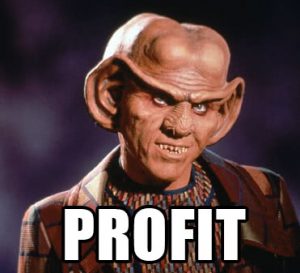

This movie’s business-oriented makers must have been certain that mangling the very foundations of the “How to Train Your Dragon” story would be more profitable than staying true to its foundations. Both the original book version, and the first movie and TV series shared a lot of positive values.
Major (or even any) “accidents” or “mistakes” don’t happen in a movie that took at least 3 years and cost US$129 million to make – especially in our current difficult financial climate and coming from a leading animation studio with some of the finest talents available anywhere, working for them.
That means every single decision, word, movement, glance, sound and pixel is mulled-over by various professionals in their field, and therefore noticed.
It seems that the positive strengths and values that followers of this story have witnessed grow over the years, weren’t able to stand in the way of basic greed.
The resulting negative and perhaps even damaging influence on the impressionable minds of those who’ve invested their energy in this movie/TV franchise, is worth considering. This movie/franchise is a major project, after all – seen and experienced by millions of people.
Positive stories that “build up”, rather than “tear down” can certainly make a profit, as well.
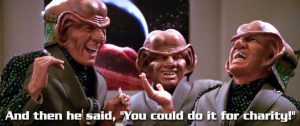

If the negative outcomes caused by such harsh pursuit of profit are so vast, then why not take a paycut? One can then even save money and energy on advertising, that tries to convince people of things that aren’t as true as they could be, or once were.
I’m curious to know how much money this movie would have made, had the story remained true to its foundations. With this being an almost-exact science by now, I’m quite certain that some experts-in-their-field would have come up with an accurate number, that may (or may not) have been smaller, but by how much?
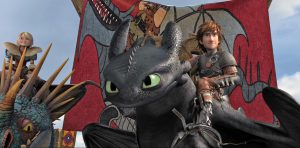

Don’t misunderstand me – I’m actually of the opinion that as long as one personally doesn’t “lose their own soul”, honestly and ethically earning money, wealth, fame, success, admiration and everything that comes with that is a good thing.
(These things always create new problems, yes, but they create a higher quality of problems – which then require higher quality efforts and self-improvement to overcome. Even when one doesn’t reach their goals – their journey would make them stronger.)
It’s deeply disappointing to witness however, when virtues are stepped on in order to grab that extra exquisite little morsel just out of reach. I’m talking about major corporations/businesses here – not the beggar on the street, who steals medicine from a chemist to heal his dying child.
Why couldn’t this franchise (with its strong history of mostly going in the positive and right direction), make one final mighty effort to the very (positive) end, instead of doing a hasty u-turn for the worse?


Whenever I see a good story getting horribly mangled in some form, I think back to the first time I saw the 1999 Hallmark Entertainment movie adaptation of George Orwell’s “Animal Farm” “fairy story”. The ending of this particular, highly political movie, was completely and brashly altered to suit the personal (and official money-making) “politics” of its current-day tellers.
Admittedly, at the time (having been a huge dog-person like today), I had only bought the DVD version when it was released, because of the cute animals (especially dog) on the cover.
The warped ending of that movie stood out from the story like a moist fart from a Gronckle, and left a lasting negative impression on me. I never bothered with that movie again, but the movie’s doggie was a real star, so it wasn’t a complete waste of time.
The final HTTYD movie didn’t turn out all that different, except that the warped plot change has now been craftily blended into the entire movie itself, rather than just into its ending, so the shee viewer doesn’t really notice the changes. Very “crafty”, indeed.
I don’t really know the (thought)-process/reasoning behind the warped ending in the 1999 movie adaption of “Animal Farm”, but it all seems to smell just like what happened to the story of this final HTTYD movie.
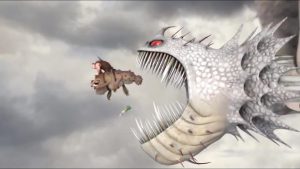

By the way: apparently, a wet Gronckle fart can even put off an unbelievably powerful “Screaming Death” dragon!
In the TV series episode “Cast Out, Part 2”, Fishlegs (a Dragon Rider) and Meatlug (the Gronckle dragon) were caught inside the mouth of the Screaming Death, and about to be killed. However, Meatlug loudly farting inside its mouth, revulsed the huge dragon into spitting them out and retreating.
Part of me wishes I had never noticed these things in “HTTYD: The Hidden World”, because the mangled story of that movie dismantles the positive effort put into the entire story, from its very beginning.
After writing this review now, I’ve gotten some things off my chest, but don’t feel any better.
There are probably more examples, but I’m going to put the warped portions of this movie where they belong (in Shrek’s smelly ground-hole), and move on to more pleasant subjects now:
Getting back to the timeless beginnings
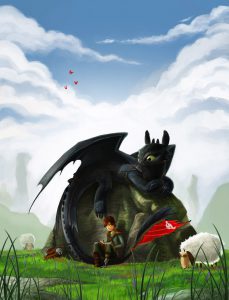

So, how can I still remain a fan of a “fairy story” that hasn’t turned out as positive, as I had hoped? (Even goodbyes can be positive!)
Acknowledging the undeniable quality and effort that went into making the overall HTTYD story, is a good start. Then, observing in reverence the scale of the entity that brought the story to us, and focusing on the positives that remain:
Peoples’ beautiful fanart which reflects many of their own (and our) idealistic dreams, and the at times interesting fanfiction with its own interpretation of this remarkable story.
In the end, I think that overall it is mostly the audience and fans who have gotten things truly right, and deserve the greatest amount of positive attention. They have overwhelmingly taken the good things in this story, and in one way or another, big or small, felt or expressed their own desire towards a positive future.
The most amazing fanworks created by artists/creatives, and the many fans who chose such works as their favourites, have demonstrated this. It’s something that I myself enjoy witnessing – seeing many other people choose positive idealism, as something favourite.
It wouldn’t however make sense to not acknowledge the positive achievements of the talented people who made and brought this story to us in the first place – with or without any farts and earwax that may be present.
Politics/farts aside: I’m a fan of the entire HTTYD franchise and ultimately wouldn’t mind watching this movie (along with its marketing mechanisms) again, for educational purposes. The story as it is doesn’t quite sit right with my own outlook that idealism should come with foresight, and that consequences must be owned from a place of strength rather than overwhelm.
Easier said than done, I know.
![]()
![]()
My review would have been much shorter, had the story been pleasing to me. I would not have been compelled, to share and revisit my own values as well.
Before watching “The Hidden World”, I had seen the first HTTYD movie in August 2018, and the second movie and TV series (and original book series) in the following weeks/months.
My memory of the entire story is still quite fresh, as are the positive feelings I’ve had towards the story of the first movie and in general also the books and most of the TV series.
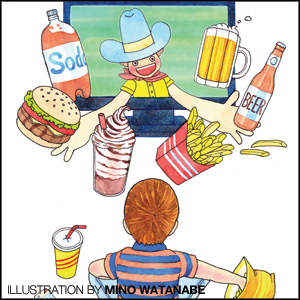

This third and final movie therefore came as quite a personal disappointment to me – not because the dragons had to leave – but because of the many hallmarks of low quality fanfiction that the aging and ending story was no longer able to escape, along with the cold, mighty and clinical marketing mechanism that now extra-loudly claimed the opposite to be true.
I don’t enjoy being cynical but I know what quality looks like, and I’ve seen it in the original HTTYD book series, as well as most of the first two movies and TV series. It would have been nice to see the story leave the best for the very end, instead of having it run out of steam.
(Lion) King = rule, Hidden World = hide? Pick your fairytale to like. By the way, I don’t remember any children crying at the end of The Lion King (1994). The many people who saw the movie together with me, were cheerful and in high spirit.
Maybe things have “moved on” since then, and all this is actually the “New Normal”.
6/10 for this movie.
10, minus 1 for Shrek loudly farting in the pond, not holding his breath while the gas dissipates and actually enjoying it, minus another 5 for wiping himself with pages of the HTTYD fairytale book, and plus 2 because I’m a HTTYD fan and can therefore ignore some faults – but it’s not easy.
How this movie could have been better
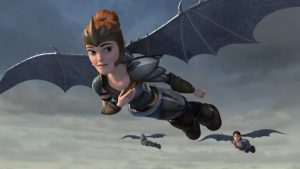

The movie “How to Train Your Dragon: The Hidden World” could have been better, if its creators hadn’t done away with all of the major character and life developments that came about in the TV series. 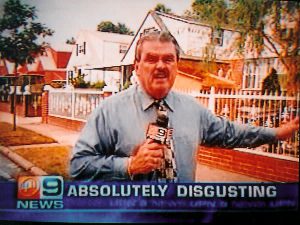

In addition, it would have been more logical and satisfying, if it had managed to dodge the urge of becoming a highly partisan part of today’s dividing and synthetic, purely-business-oriented mass-consumption-media.
Unfortunately, the second previous movie already had disruptive elements of this trend. Therefore, if this third movie had been done better, it would have needed to address the problems with the previous movie as well.
Somehow, the story of the third movie, would have had to explain why all of the dragon-friendly allies that the Viking Berkians had already made (in the TV series) – for the duration of the second movie – were nowhere to be seen.
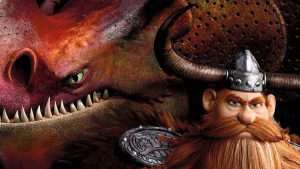

The TV series did explain why and how Berk’s Chief Stoick, for example, had a “Rumblehorn” riding dragon in the second movie. Apparently some parts of the TV series were used for the movies’ storyline, and other major parts weren’t.
What is important to point out, is that it would have been impossible for the Berkians to hide the fact that they were now friendly to dragons – their island of Berk was not a secret. Traders, passers-by and dragon trappers and hunters all would have instantly known of Berk and their newfound love for dragons!
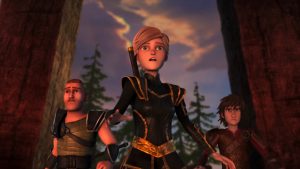

One of the reasons to explain the absence of the Berkians’ human allies, could be that Hiccup and Chief Stoick didn’t want to involve other dragon-friendly tribes in a growing conflict, that (for the time being) mostly involved the Berkians.
In the (better version of the) third movie, we could have seen this explained as a flashback, or just as a discussion between Chief Hiccup and the Dragon Riders (Astrid, Fishlegs, Snotlout, Ruffnut and Tuffnut).
This discussion could have been brought on by a growing realisation, that the Berkians were starting to get involved in increasingly large and dangerous matters. A solution to push back against those serious problems and deal with them constructively, may after all, involve bringing in like-minded friends.
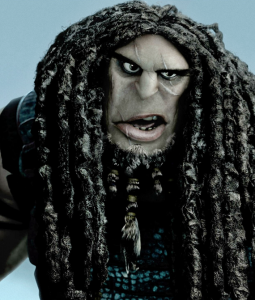

In this “better” version of the third movie, we would not have even required a “Grimmel” – we already had one like him, in the second movie, in the form of “Drago Bludvist”.
A more “mature” kind of “final boss”, conflict and required resolution, would have been the insightful recognition by all dragon-friendly tribes, that the exploitation of dragons will likely never cease in their lifetimes.
This realisation could have come, after more battles with their big explosions and special effects, to keep the viewers “hooked”. However, ultimately near the ending, things could have quietened down, the battles won, but with the biggest final battle ahead of them – the battle they must face within their good hearts and deepest desires.
The Berkians and their dragon-friendly allies, could have begun the process of reversing their dream, of living in friendship together with the dragons.
They could have begun to accept, that as long as mankind does not have suitable alternatives to exploiting the dragons (which represent nature, animals, weapons, might) for its own gain, that it would see no good reason to stop its destructive behaviour.


To protect the dragons and also themselves, the Berkians and their dragon-friendly allies could have begun a slow and methodical process of separation, by creating the Viking-World’s most amazing lie, and swearing to never reveal the truth:
They could have lied to the rest of the world, that all the dragons had gone to their “Hidden World”, like was seen in the final scenes of the “less good” version of the third movie.
This lie/illusion could have given the Dragon Riders more time, to implement a clever plan.
This clever plan could have allowed those dragons, which required time to adjust to their new environment inside the Hidden World, to still have lived on monitored and well-protected areas/islands on the surface. All dragons would have been free to leave the Hidden World, as long as they were careful not to be seen. This would maintain the illusion, that the dragons had truly left.
Pretty much every dragon in the movies was adept at camouflage, so it wouldn’t have been a stretch to imagine them being even more careful now – especially with guidance/training by Toothless, the alpha dragon.
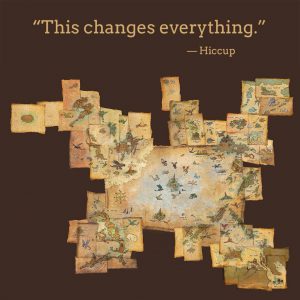

There were many dragons living amongst the Vikings’ Archipelago, and possibly beyond. The process of finding them all, and transferring them either into safer areas away from humans or into the Hidden World safely, would not have been easy. The process would have had to work, without being detected by unfriendly humans.
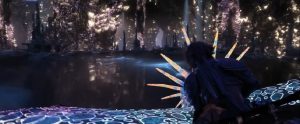

The environment inside the Hidden World could also have been altered to better suit those dragons, that had adapted to living on the surface amongst humans.
There were certain dragons too highly specialised to live inside the more-or-less barren network of shiny caves that made up the Hidden World.


A lot of dragons couldn’t even enter the Hidden World without killing themselves on the jagged rocks, due to being flightless. These dragons could have been carried down into the Hidden World over time, by other dragons. It may have been possible to transport certain vegetation which some dragons completely relied on (such as the Buffalord and its herbs) from the surface, to inside the Hidden World.
Overall, this would have been a slow process, perhaps even taking decades, and could have been the dragon-friendly humans’ final gift and “Thank You”, to the dragons.
During this process, they would have stayed in contact with each other.
To help the dragon-friendly humans themselves adjust, the dragons would have continued to help the humans wherever reasonably possible. The humans would start replacing and training other animals to take over the roles of the dragons, and set up various kinds of defenses and fortifications against other, overall unfriendly tribes.
The dragons could help speed up the process, so that their human friends won’t be left vulnerable and mostly defenseless.
To try and “smooth over” relations with the many dragon trappers and hunters left without dragons and therefore without a “job”, there could have been a string of new “job” opportunities intentionally created by the dragon-friendly tribes. As much as the Berkians (and friends) were hated, if there are other profitable jobs and there’s always food on the table at home, then hunting the Berkians down “in revenge” may just have been slightly lower on the list of priorities, after all.
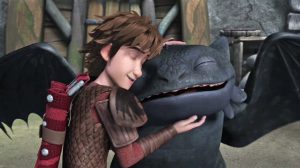

The dragons’ final gift and “Thank You”, would be to help make sure their human friends who love them (and have centered their lives around the dragons’ welfare), don’t suffer as a result of them being separated from each other.
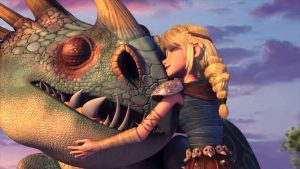

True friends look out for each other, after all, don’t they?
Because the dragons are already good at hiding from humans, all of this could be done without anyone else finding out for certain. The illusion of the dragons’ complete disappearance could continue with cleverly-spun tales of myth, that will only make any accidental and “real” dragon-spottings look ridiculous.
(Kind of like accusing someone of drinking too much, or saying they are exaggerating, when that person tells everyone that he/she had been “abducted by aliens”.)
This would then have been a tale of natural (not artificial) growing maturity and triumph. Even though the dragons had to leave, they left without damage or suffering to anyone. The Vikings and dragons separated, with both being better off and stronger, than when they had first begun their friendship.
That alone would have been an amazing achievement that no one else had been able to manage, in this fairytale.
The dragon-friendly Berkians and tribes would have earned a proud history and legacy, that they could have passed down to their children: Such as, that even though dragons no longer live amongst them, they once were able to live together as friends, and also part ways as friends, now being stronger and wiser than ever before.
This legacy being passed on, would then have been one of victory over personal limitations, with genuine hope and also the foundation for a brighter future, that extends beyond their own homelands.
Does that not sound better than a story of finger-pointing, division, hatred, defeat, loss and false hope?
At least, it also sounds like something we could have ended up seeing from the characters in the first movie, TV series and also the second movie, as well.
– Notes
The above quoted Viking and Norse aphorisms have my interpretations in parentheses beneath them – they are not “official” interpretations, but my own, so feel free to come up with your own interpretations as well.
If you quote the aphorisms from here, make sure you check their sources and read the relevant parts of the sagas to verify their context for yourself. Copy/pasting them into a search engine should give you a good start, but try to look for authoritative sources.
Here are some links to sources I have used: usask.ca/english/icelanders/index.html | sagadb.org/index_az | vikingsofbjornstad.com/Viking_Wisdom.htm | anomy.net/havamal | hurstwic.com/history/text/history.htm
Yes, the HTTYD movies certainly aren’t “historically accurate” – but that’s no reason for the characters behaving in ways that wouldn’t make any sense either in the Viking Age, or today, or behaving in ways not true to their earlier presentations.
In case you want to fly (with your best friends), these links may be of interest:
That’s Incredible (1980) – “Incredible Canines” Segment
youtube.com/watch?v=iGc4QTA1enk
American Journal (1994) Hang Gliding Dogs
youtube.com/watch?v=ZTCsdUp2vps
en.wikipedia.org/wiki/Hang_gliders | en.wikipedia.org/wiki/Paragliding | en.wikipedia.org/wiki/Ultralight_aviation | en.wikipedia.org/wiki/Gliding





www.dailymail.co.uk
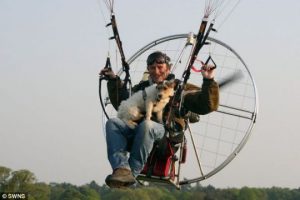

metro.co.uk
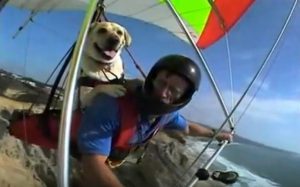

Updates:
This Bewilderbeast-sized PhD dissertation movie review may get some updates in the future, and I’ll add them here. A note of such updates will be made on the “Planned Updates & Updates Log” blog post.
The interpretations of the Viking and Norse aphorisms are still to be completed, and since I’m not a fan of ending a paragraph (or story) on a dark note, I’ll be adding more “how it could have been done differently” type of text. (Feel free to share your own ideas in the meantime.)
So far, I do have an “Alternate HTTYD Hidden World Story and Ending” blog post, where these ideas might end up in the future.
I might add more screenshots and other images, as well.
The “Hidden World ending and when we’re ready to get along with the dragons, and they say hi” parody video may sometimes fail to play on Firefox browsers.
You can use this direct link to a less compressed file (375MB MP4), which will bypass the video player function that gets requested by the linked web page – in other words, the direct link might work if the normal link doesn’t.
Also, you might need to enable cookies, for the videos to fully play.
